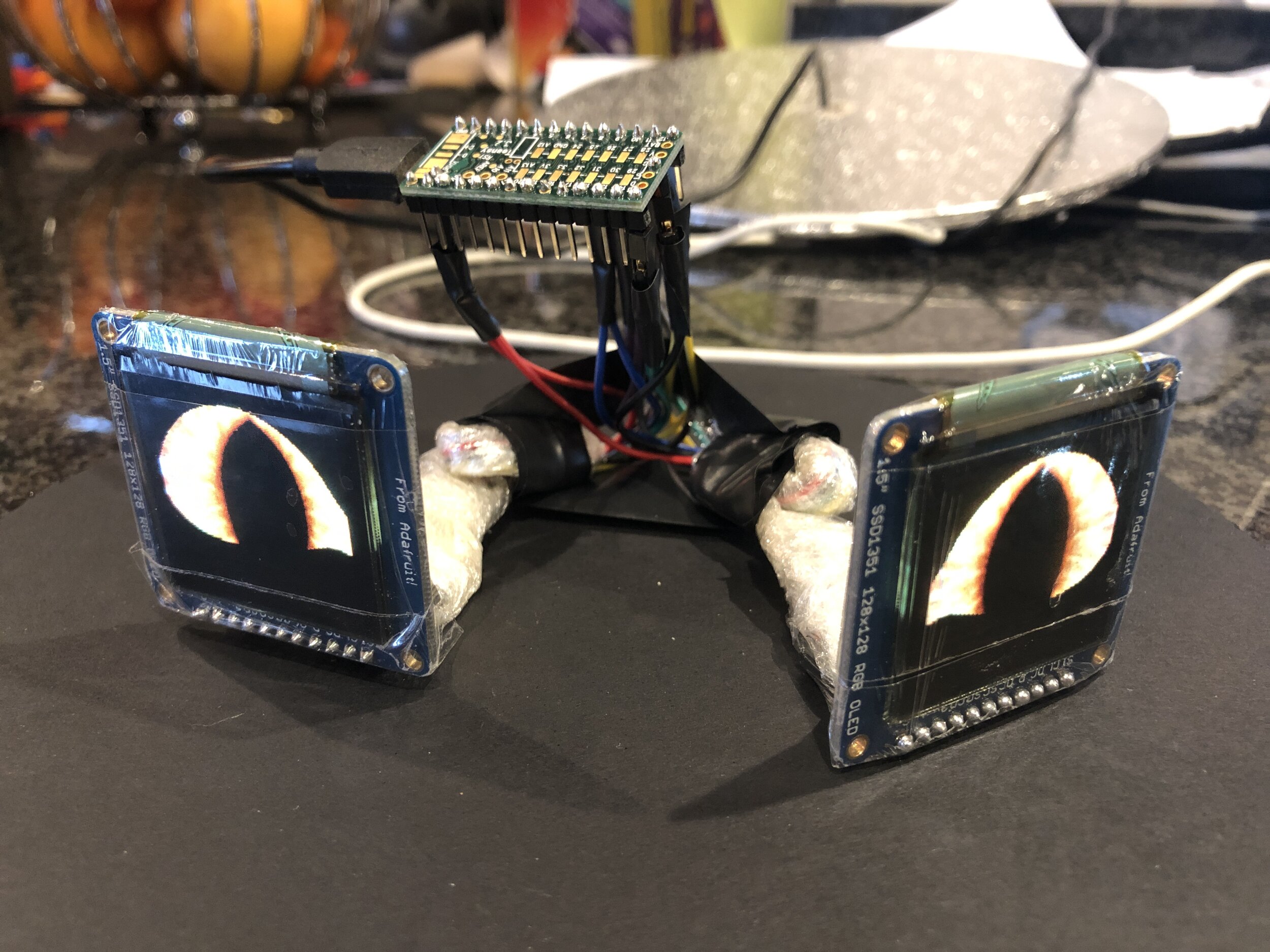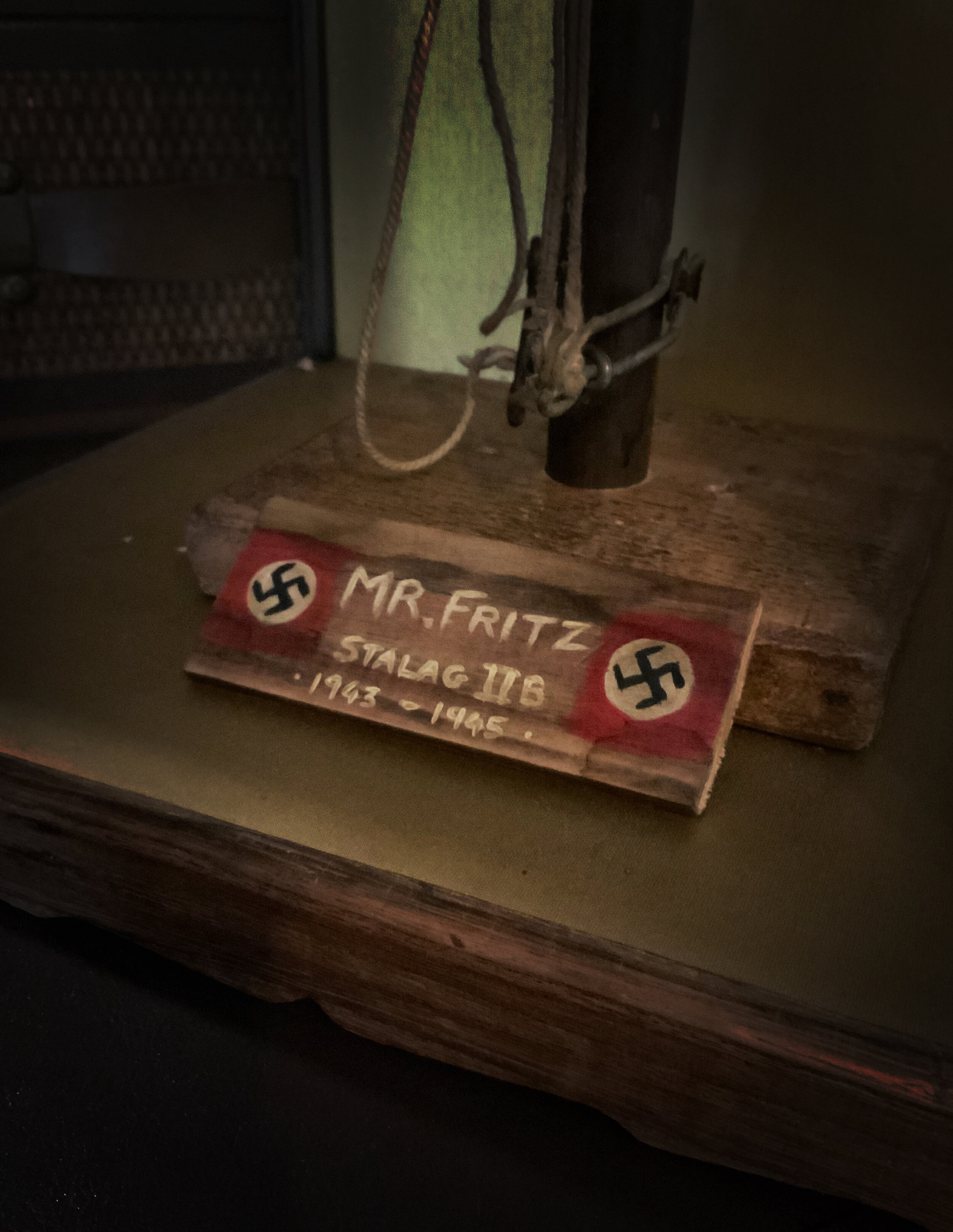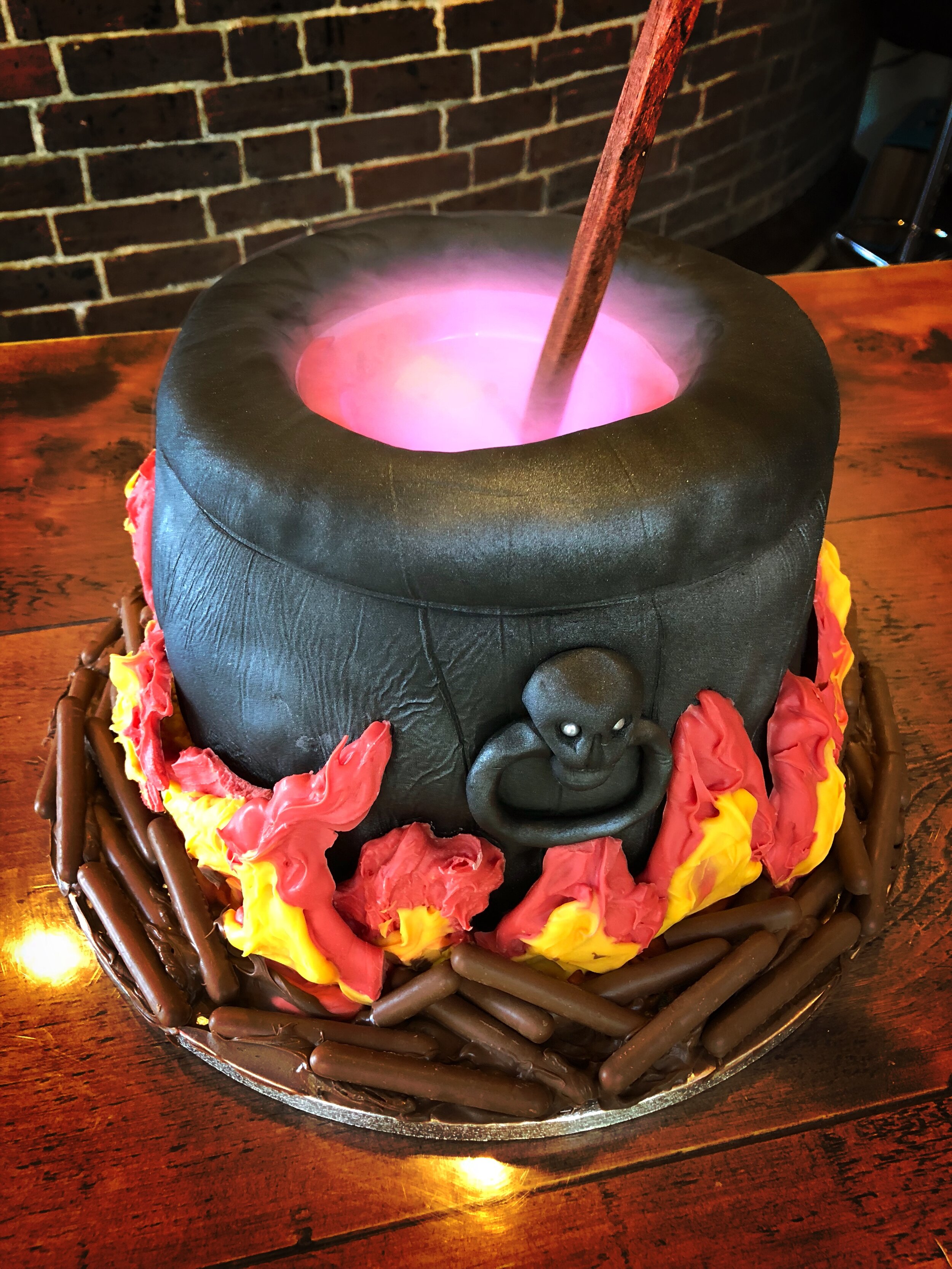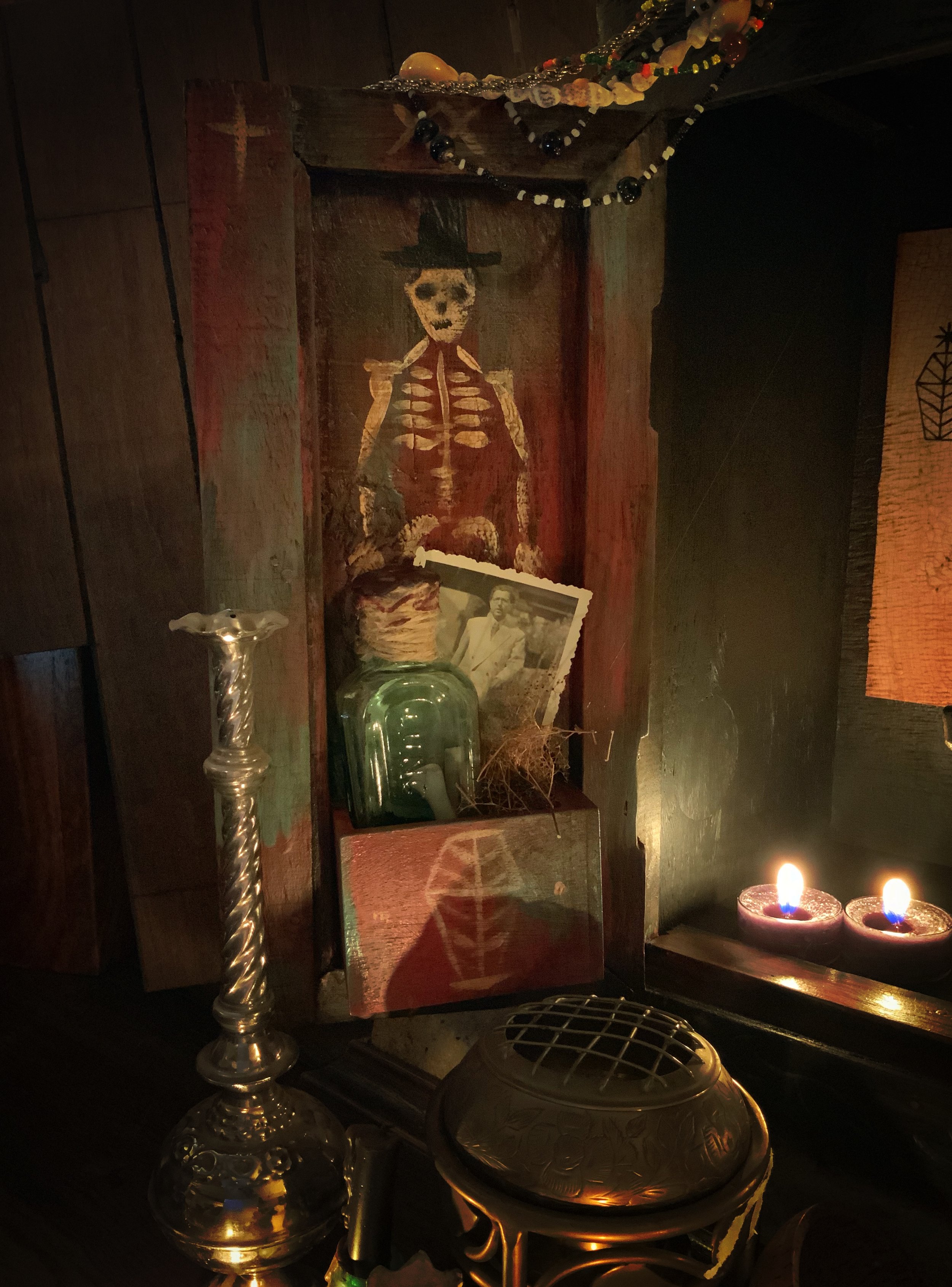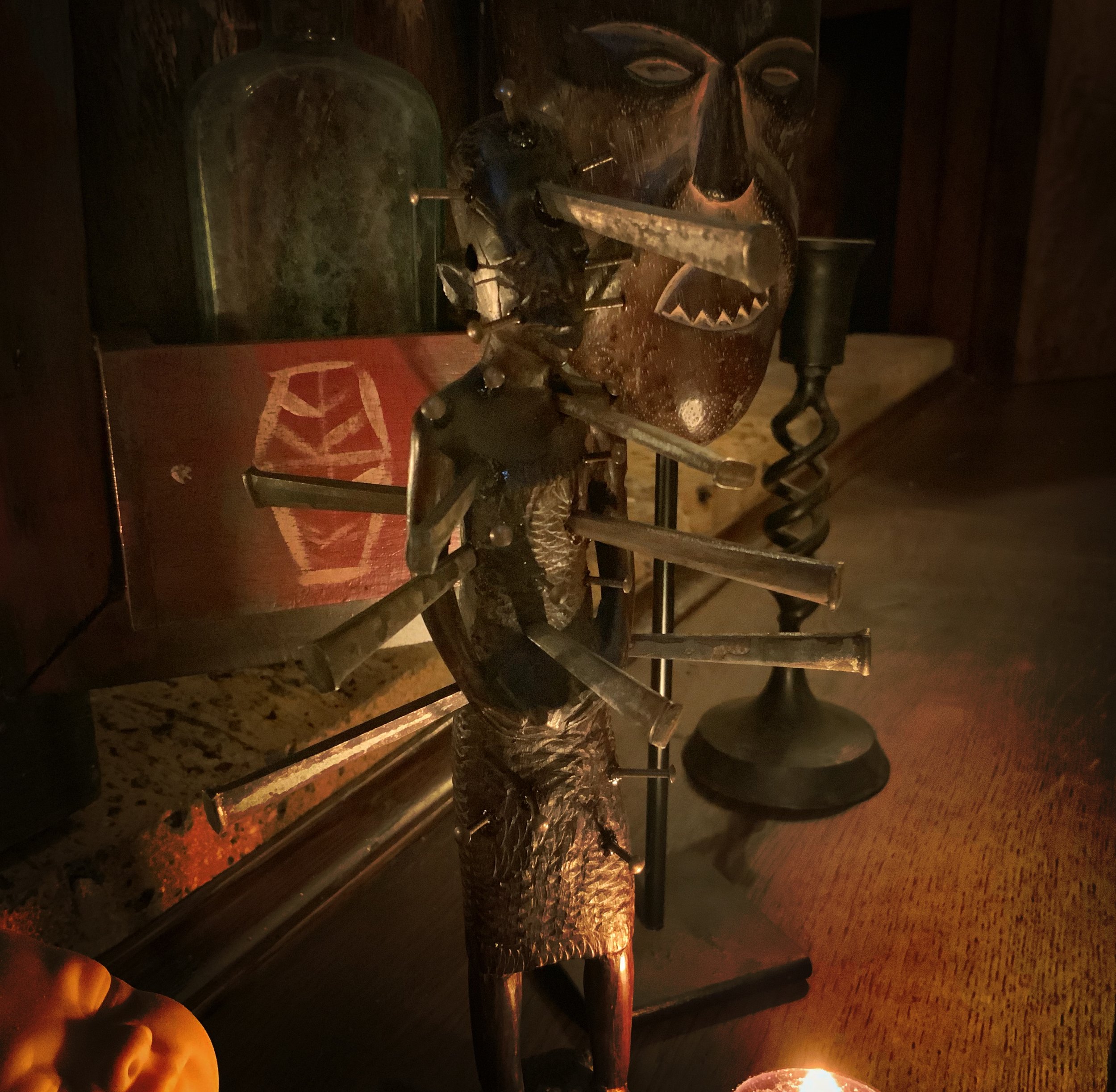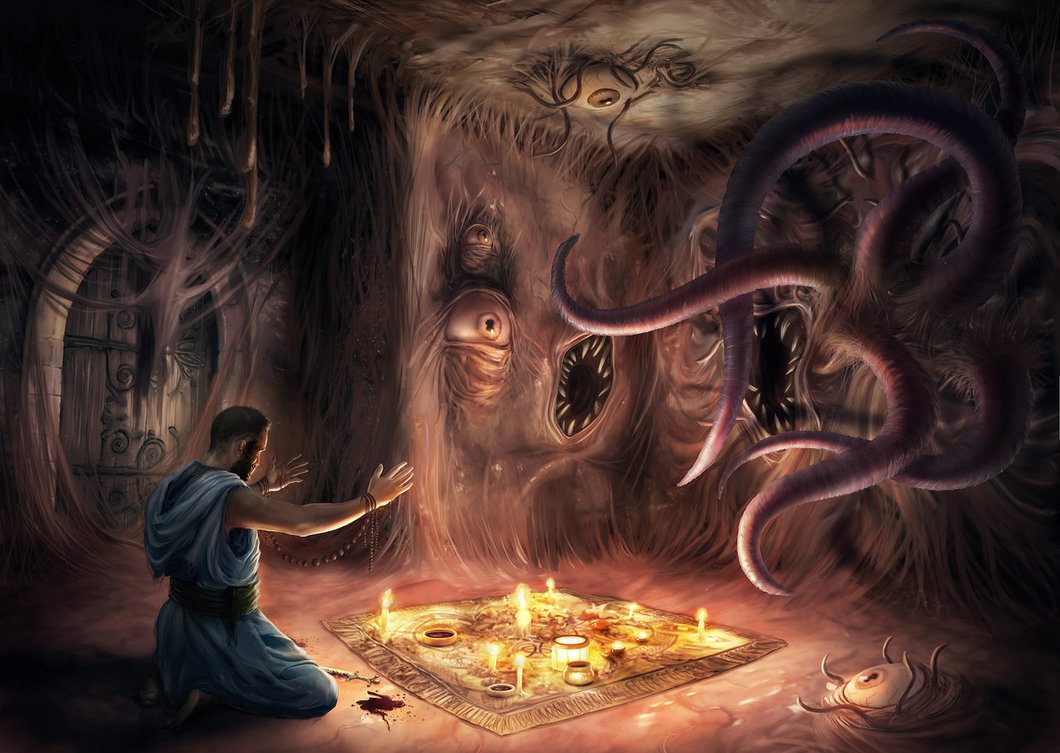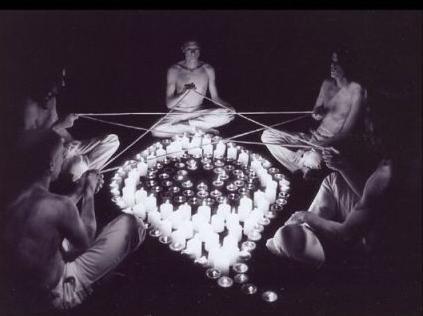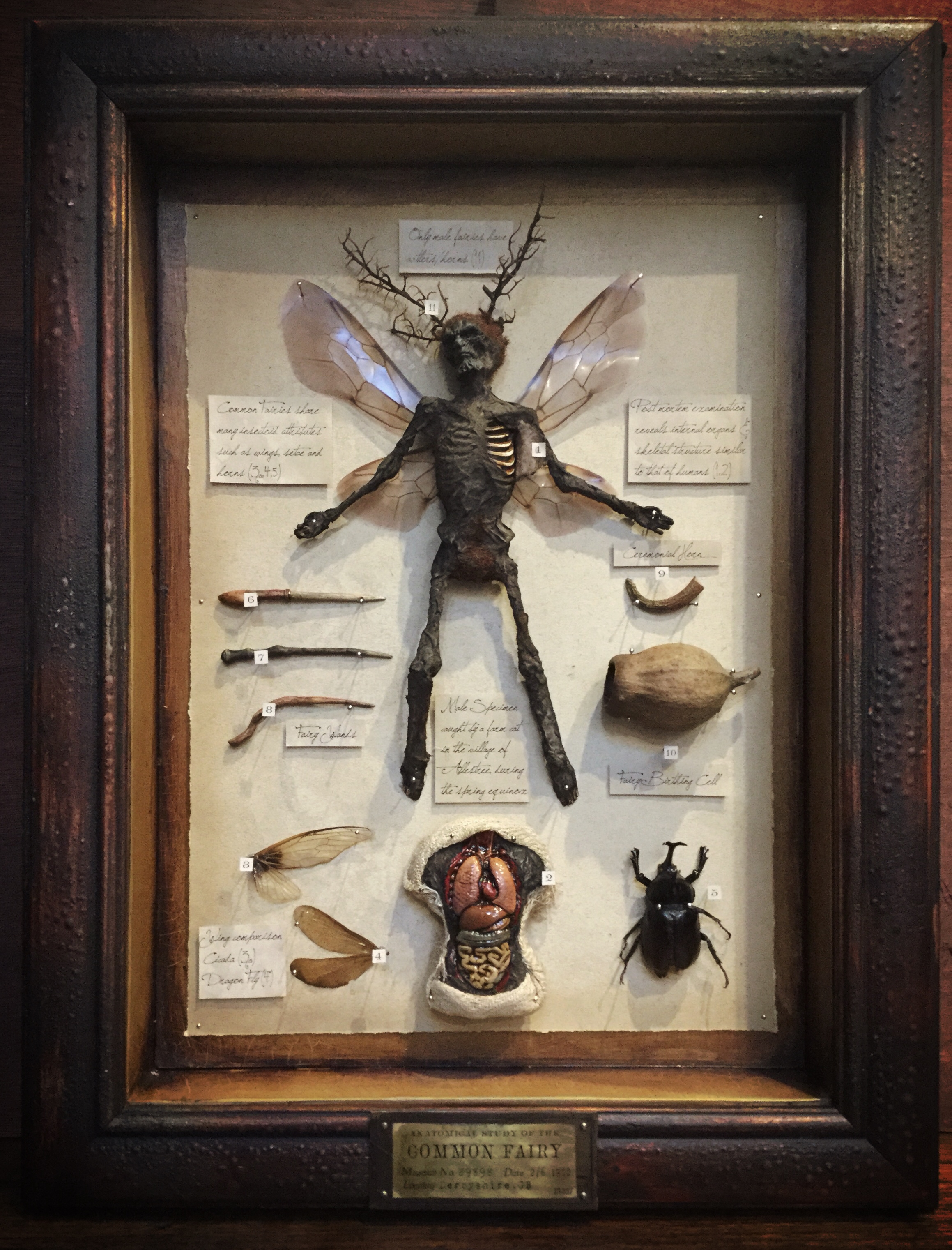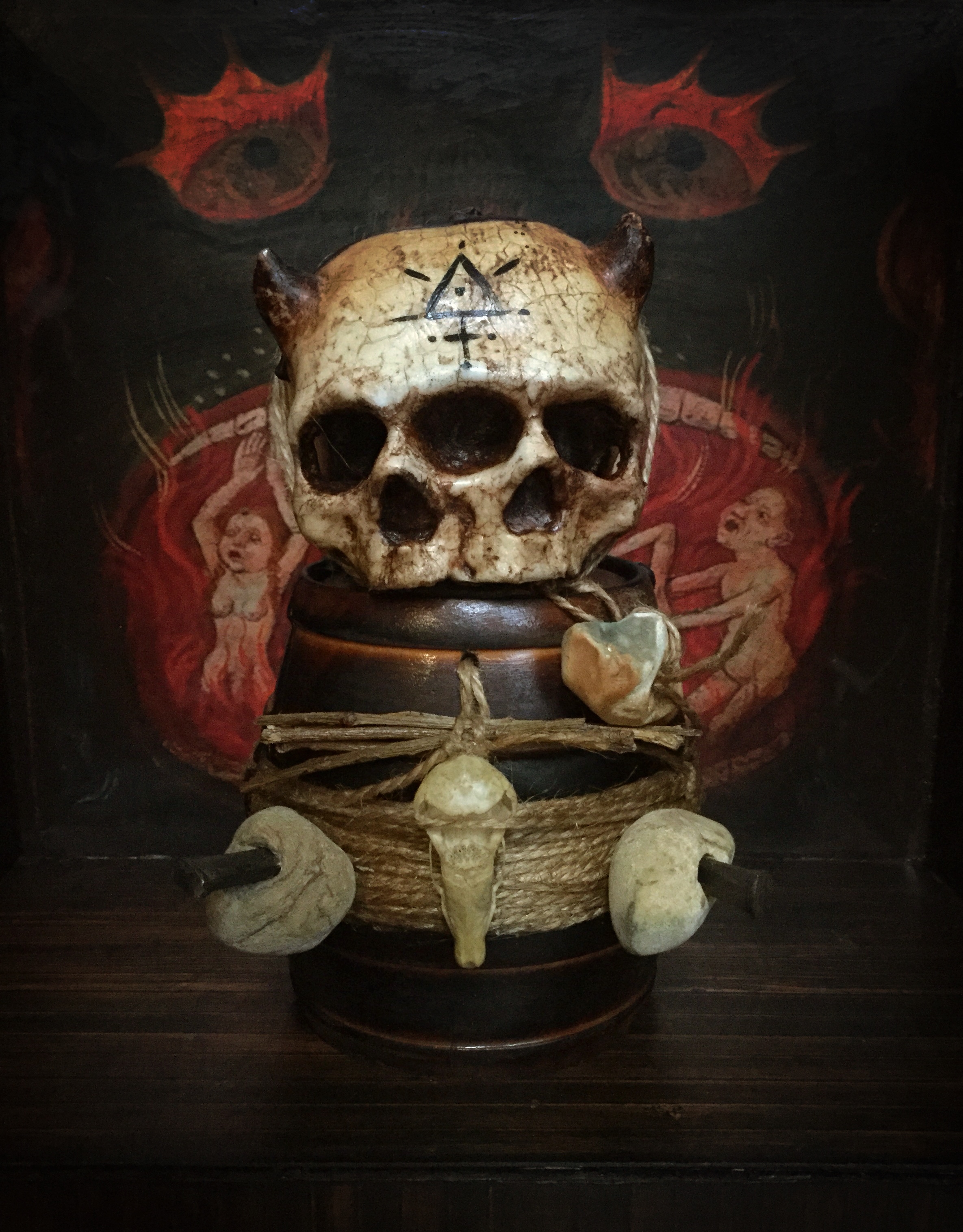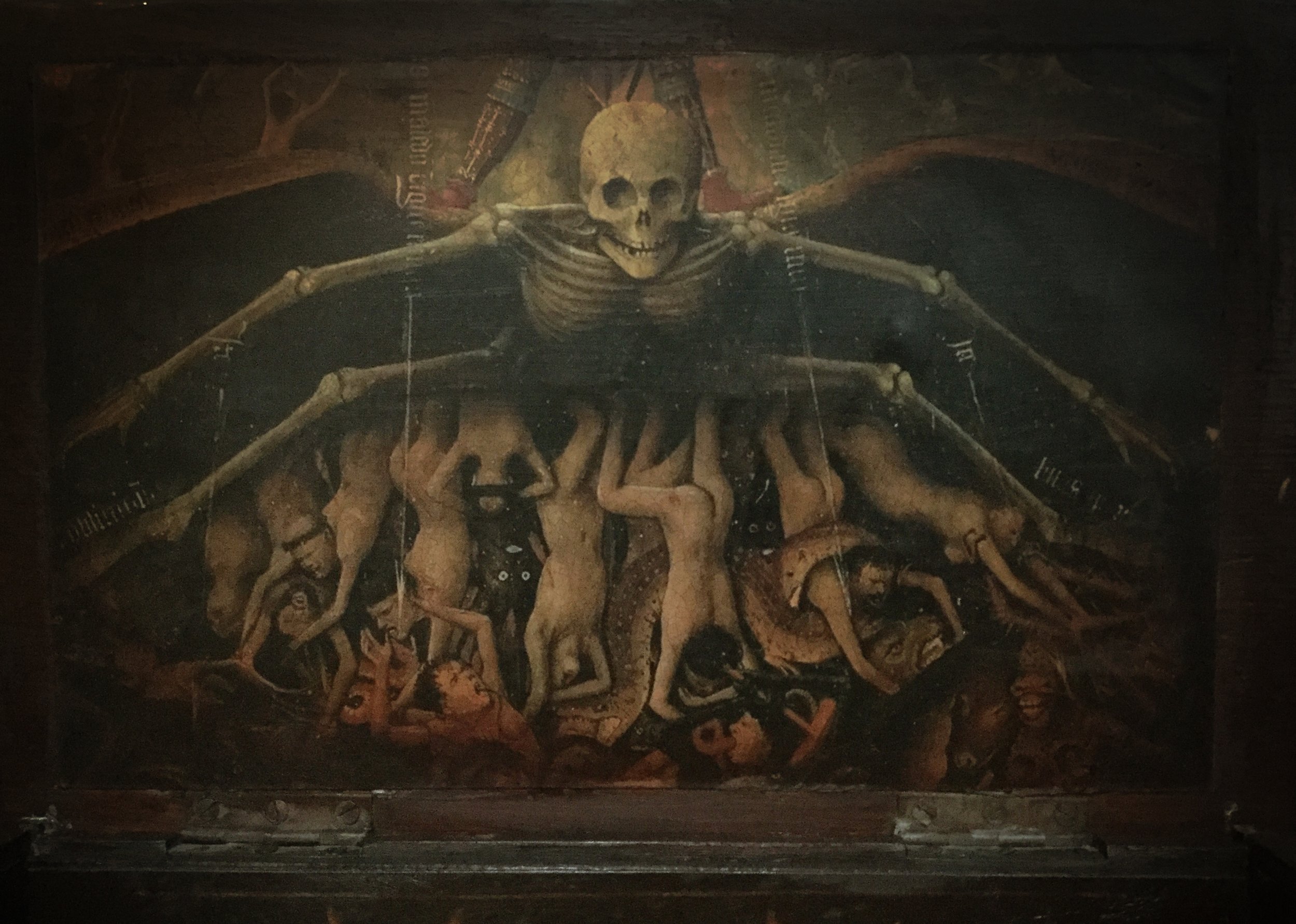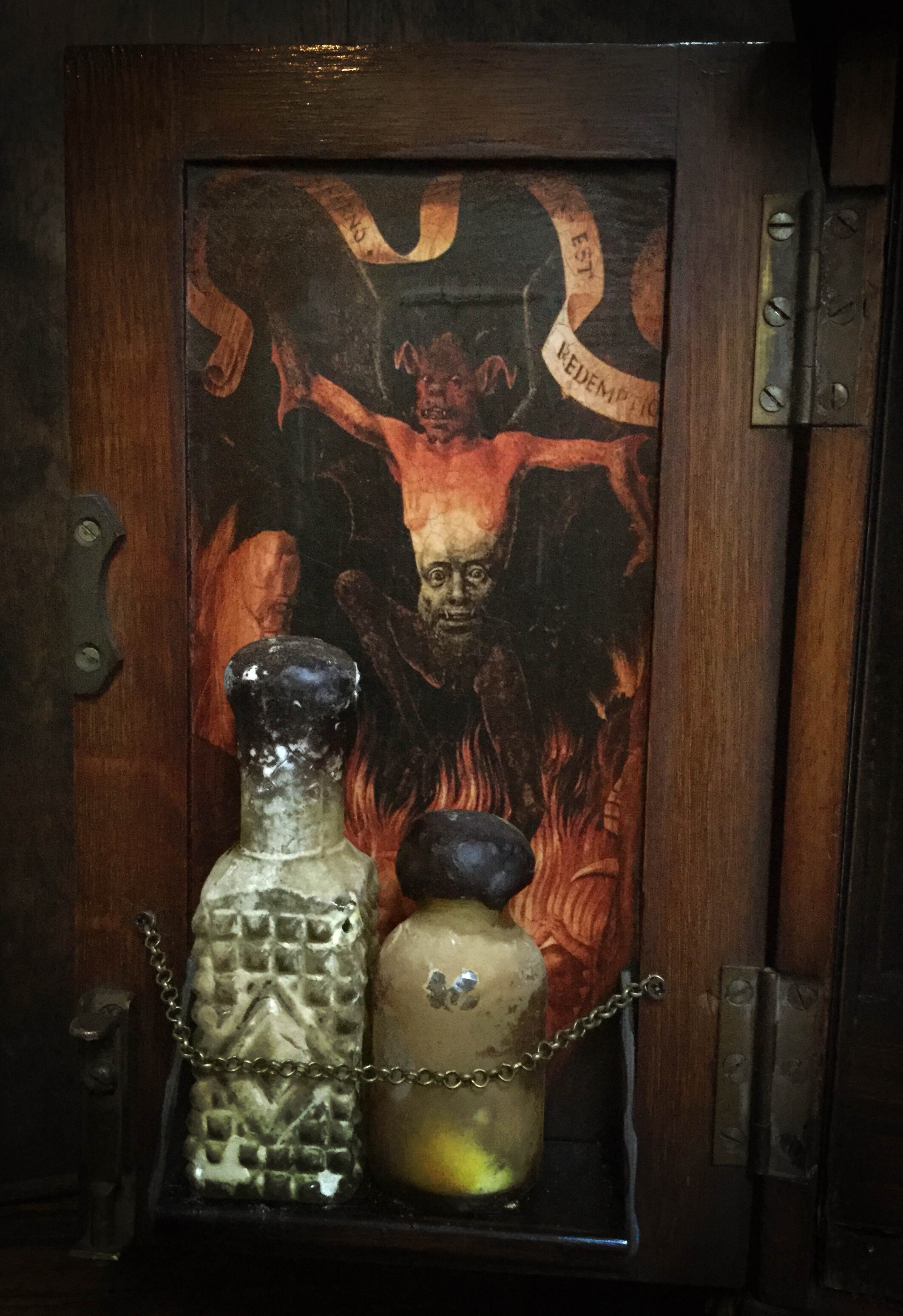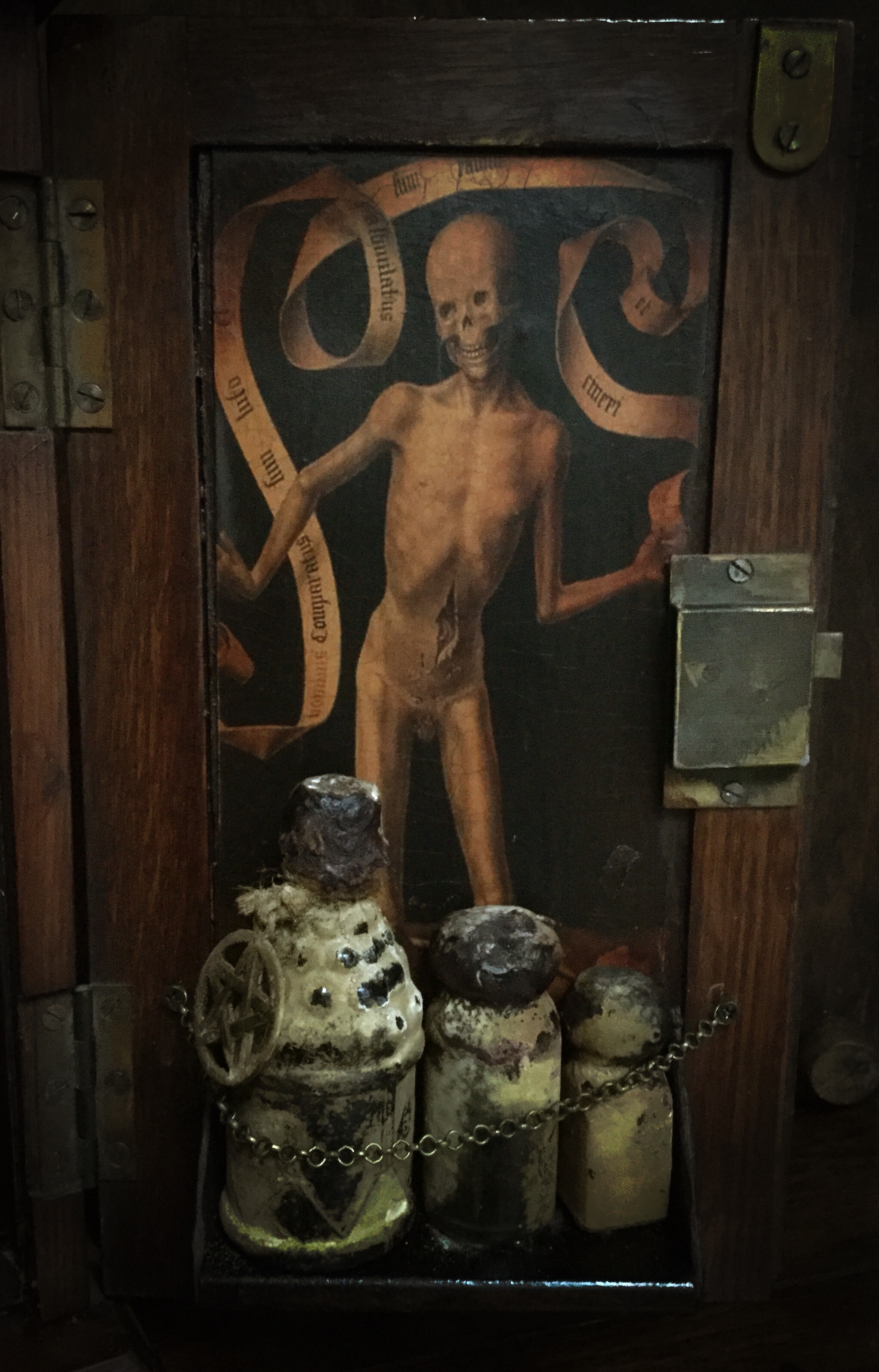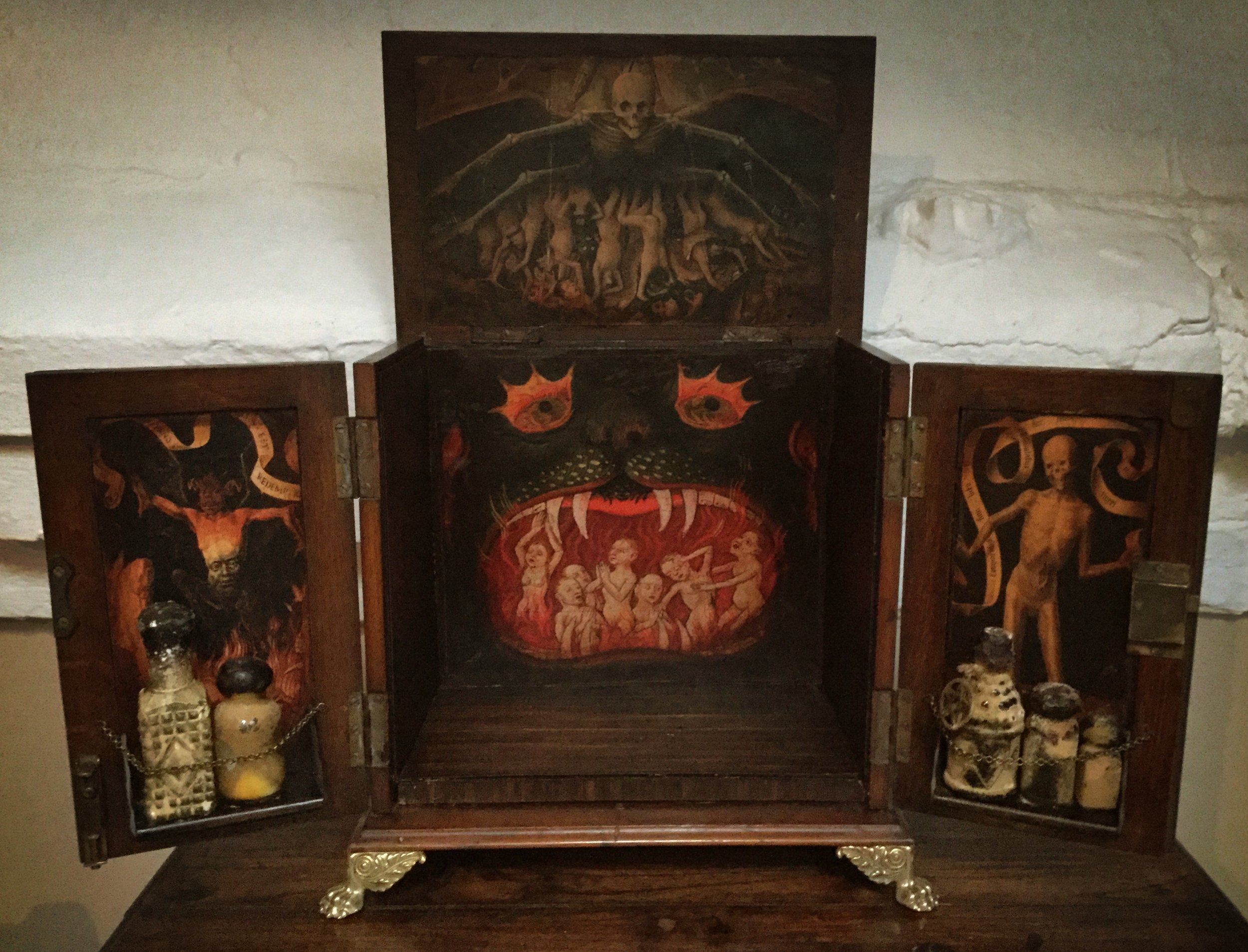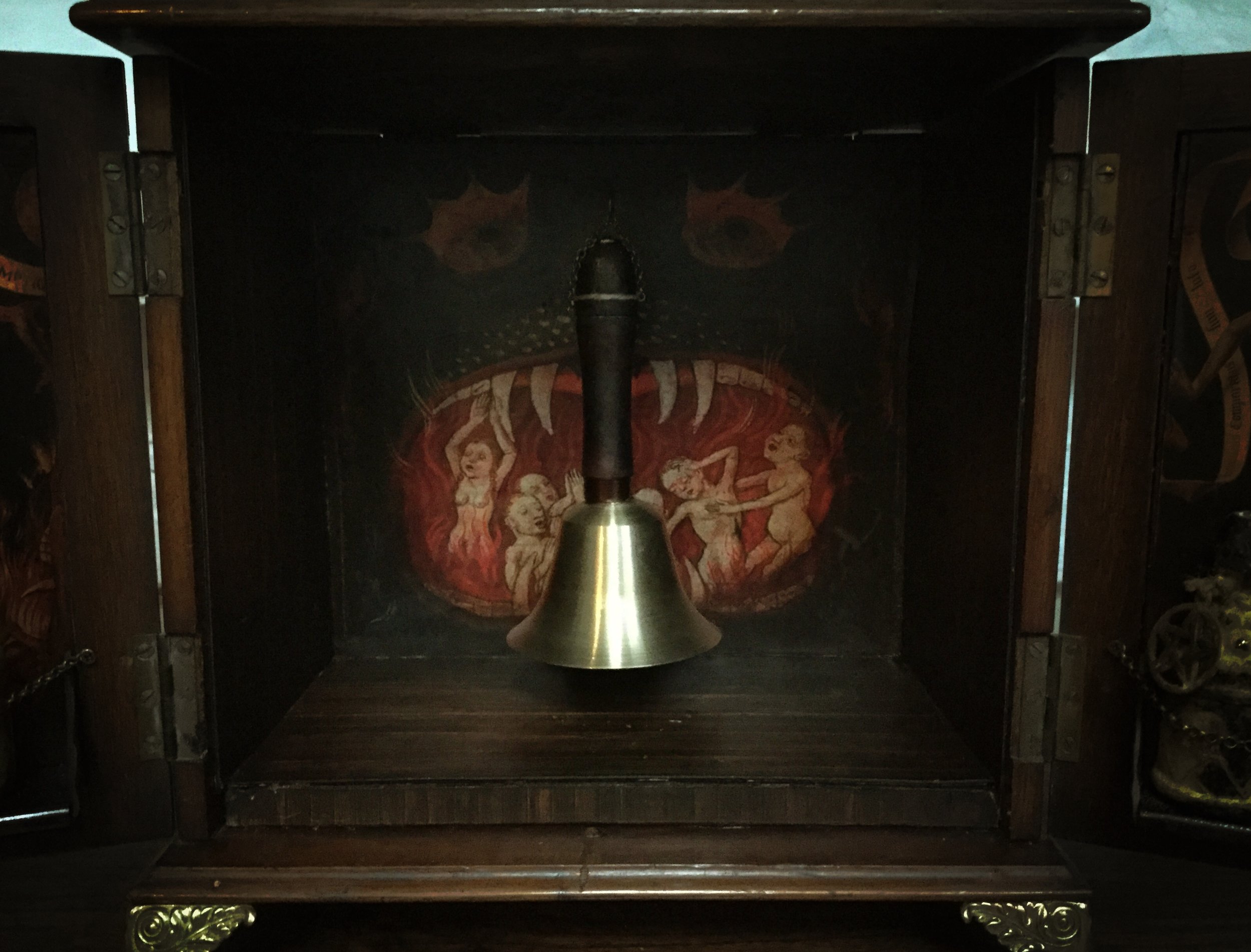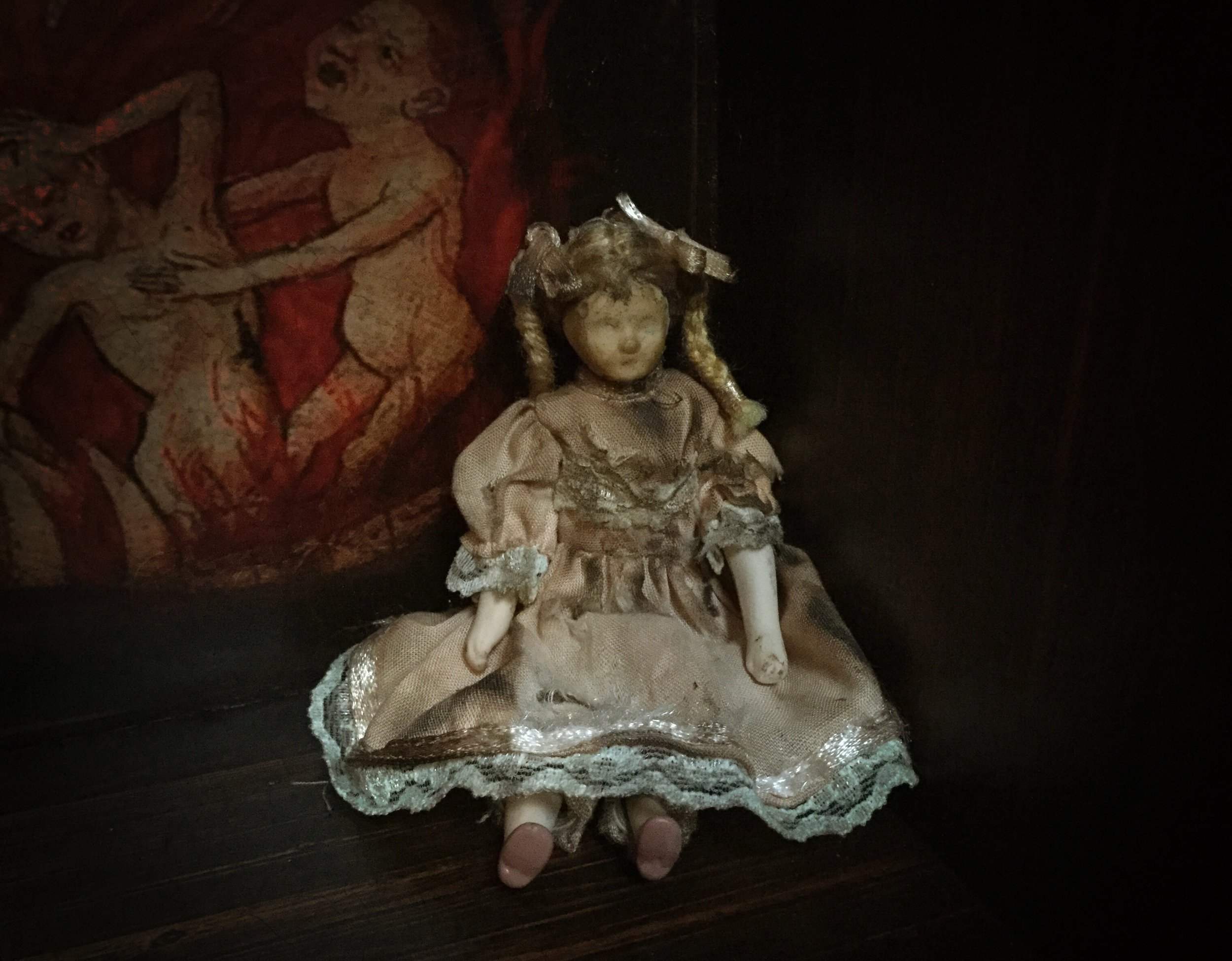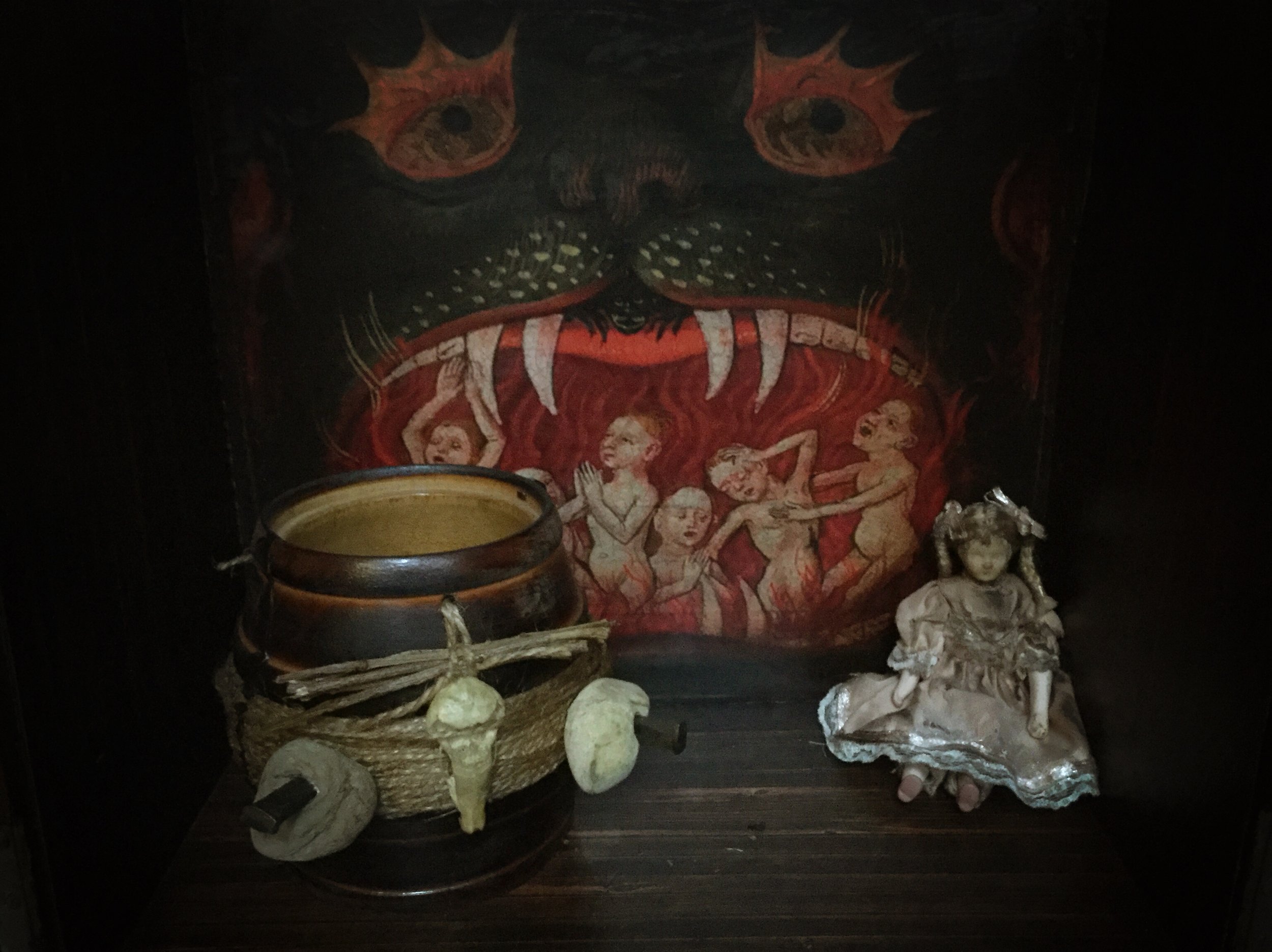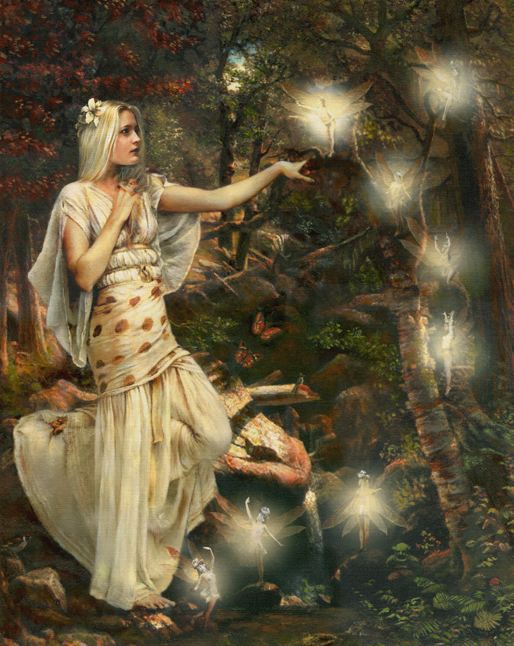Evil Cakes for Kids Part III - The Cake with a Thousand Eyes
Oscar is one lucky boy. Being an October baby makes him a Halloween baby and guess what? Here at Castle Von Baines we LOVE Halloween! It's no surprising then that all of his previous birthday cakes have had a spooky theme with last year's Harry Potter Cauldron topping the chart for most liked cake EVER. So what creepy delight would grace the party table this year? The cauldron was a tough act to follow but armed with my trusty piping bag, cake tins and soldering iron I set to work in true Shellian fashion to create a living but totally edible monster cake. It's alive!
Fortunately, in order to breath life into my monster I didn't need to rob graves or harness the power of lightning, I just needed some eyes. Not real ones of course, these eyes were created using a Teensy 3.2 microcontroller and two rather small computer monitors (1.5” OLED displays). These would be embedding in the cake to give the mass of flour, eggs and sugar some personality. A tutorial on how to build and program the eyes can be found here.
The eye circuitry was mounted in a dummy cake slice enclosure made from card. A section of cake was removed and the eye circuit was slotted into place and secured with a dollop of buttercream.
The recipe I use for my cakes is perfect for 'construction', you can stack two or three layers without the need of internal dowels for support and they don't collapse under the weight. They are light and moist but slightly denser in texture that you’d expect from a standard Victoria Sponge. I personally prefer 'heavier' moist cakes like apple cake and carrot cake
For this I used -
250g Self Raising Flour
250g Caster Sugar
250g Unsalted Butter
1 Teaspoon of Salt
4 Large Eggs (separated)
100ml Natural Yogurt
Vanilla Essence
60g Cocoa Powder (use more if you like you cakes more chocolatey)
Gently melt 250g of butter and once it is fully melted add the 250g of caster sugar and stir until smooth. Remove from the heat and place to one side to cool.
Add the salt & cocoa powder to the flour and sieve.
Separate the 4 eggs and place the whites in a mixer and beat until fluffy.
Tip the 4 yolks into the butter and sugar mixture along with a teaspoon of vanilla extract and 100ml of natural yogurt and mix.
Then add the flour to the wet mixture and gently fold until the ingredients are fully incorporated.
Finally, take the whisked egg whites and fold it into the mixture until it is fully mixed. Be sure not to over mix the batter.
Line a couple of cake tins, pour in the mixture and bake for 30 minutes at 180c. If the middle still wobbles after 30 minutes return the cake to oven for a further 5 minutes and repeat if necessary.
You can add pretty much anything to this recipe so be adventurous! My kids are boring, they only like chocolate which luckily is my least favorite meaning I don’t as many off-cuts as I normally would!
The cake consisted of three layers of chocolate sponge, with the middle layer being slightly smaller, similar to a fault line cake. This recessed area would be used to form a 360 degree mouth. The eyes were powered from a USB battery pack mounted under the cake board. To thread the wires through the cake I made a 12” long cookie cut fro Plasticard to channel a core a hole through the centre of the cake.
All of the layers were given a quick crumb coat and then placed in the fridge for half an hour while I prepared the buttercream.
Oscar has a particular fondness for chocolate orange so I whipped up a large batch of orange buttercream along with some pink and black for the mouth. The teeth were simply mini marshmallows. I had intended to make sharp teeth from white chocolate but I felt that the marshmallows gave the monster a friendlier appearance. Piping from the deepest point outwards, I started with the black followed by the pink gums.
I roughly piped the orange buttercream over the rest of the cake. I didn’t want perfect lines of icing, I was after a finish that looked slightly chaotic that emulated what I can only describe as ‘horny fur’. The ears were created using strawberry meringue swirls.
It only made sense that a creature with a 360 degree mouth should also have vision to match so I added a more eyes and an extra tongue. You never know when one could come in handy! Some parents commented on the uncanny realistic texture of the tongue. This was created by stippling the fondant icing with an egg wash brush followed by a couple of coats of confectioner’s glaze to give it a permanent dribbly wet look.
As you can see, the cake was a hit and the poor monster with a thousand eyes was promptly sliced up and shared between 20 hungry kids and their parents.
The disturbing tale of Mr Fritz – the haunted ventriloquist dummy of Stalag IIB
Halloween and Remembrance Day are a mere eleven days apart so it seems only fitting that I post this story regarding two of the most terrifying things a person should never have to encounter during their life – war and ventriloquist dolls.
The private collection of alternative entertainer Michael Diamond is home to some of the rarest sideshow exhibits and apparatus in the UK. Oddities such an elephant headed boy from Brading Waxwork Museum, real execution swords and axes, Houdini's handcuffs and shrunken heads are all on display in his 'Freak Room'. But tucked away in the corner, shrouded in a blanket is a display cabinet with a firmly locked door. The 'Freak Room' is now the final resting place of Mr Fritz, a haunted ventriloquist doll, who has struggled to find a home since 1945.
Not much remains of Mr Fritz. A solitary head, mounted on a piece of wooden pace stick, his face peeling and warped. As dead as he looks, some would argue that he is very much alive. Unlike most of the exhibits in Michael's collection which were acquired through considerable financial investment, Mr Fritz was given to him for free. Michael admits though that this was not initially unusual,
“Most people find dolls, especially ventriloquist dolls far too creepy. The unlucky ones end up being thrown out or locked in attics for years while others get given to collectors like myself”.
A well know WWII Militaria dealer in Liverpool approached Michael at a festival they were both working at over the summer. He had seen Michael’s travelling exhibition of oddities and thought that Mr Fritz would fit in perfectly. Mr Fritz was discovered in an Antiques Mall in Myrtle Beach, USA and once the dealer heard of the connection with a German POW camp he felt compelled to buy him and bring him to the UK. It was then that things started to happen.
The dealer, who wishes to remain anonymous, first started to notice something strange when he put Mr Fritz on display in his showroom. He would lock up for the night and come back in the morning to discover that Mr Fritz's display case door was wide open, even after it had been firmly shut. Every night it would be shut, yet every morning it would be open again. Things then started to take a more uncanny turn. Mr Fritz would sometimes have his eyes open, when they were normally closed. His mouth would also change position. The dealer tried to think of obvious explanations such as humidity, a breeze or even going as far to think that a mouse may have made a nest in his head. On closer inspection, he discovered it was neither of these things. Day after day the door continued to open so he finally taped it shut. The following day he returned to find the tape peeled back and the door open once more. He finally removed Mr Fritz from the showroom and placed him in the garden shed where he stayed for another six months. His children then reported hearing laughter from the shed as they played in the garden and nobody would dare go near it.
Mr Fritz had to go.
As soon as Michael adopted the lonesome remains of Mr Fritz, he placed him in the 'Freak Room' and immediately things started to happen. The door started to open. At first it was once or twice a week but soon the door opened every night without fail. He even discovered one morning that the display case was not only open but had moved six inches across the table. Curiosity finally got the better of Michael and he set up a GoPro camera to monitor Mr Fritz. As you might imagine, a doll that was made to entertain people was not camera shy and the following footage was shot over two nights in September 2019.
But what is the story behind Mr Fritz?
A small hand written note that accompanied the eerie doll explained that he was originally a ventriloquist doll who was used to entertain Allied POWs during WWII in Stalag IIB between 1943 – 1945.
Stalag II-B was a German POW camp situated 2.4 kilometres west of the village of Hammerstein in Poland. In 1933 it was established as one of the first Nazi concentration camps and was used to house German communists. In late September 1939 the camp was changed to a POW camp to house Polish soldiers and in August 1943 the first American prisoners arrived, having been taken prisoner in the Tunisian campaign. Over 600 US POWs were held in Stalag IIB and life was harsh, consisting of long days of hard labour on neighbouring farms with meagre rations.
Prisoners tried to overcome these hardships by educating themselves and staging entertainments such as musicals and comedy. Among the prisoners with enough energy to entertain was Private 'Billy' Booth who had been a children's entertainer and puppeteer before the war started. He had made Mr Fritz with German newspapers soaked in potato starch and painted him with a smuggled pot of pink gloss that a Polish farmer had given him which had been used to paint his daughter's cot.
For almost 18 months Billy Booth and Mr Fritz entertained the prisoners of Stalag IIB with 'in' jokes and songs. He was so good that even some of the German guards found him funny. But unfortunately on 14th January 1945, 2 weeks before the camp was liberated, Billy and nine other US POWs were taken into a field, made to dig a large pit and shot for not working hard enough.
When the camp was finally liberated on 28th January 1945, Mr Fritz was taken back to the US by a fellow prisoner and given to Billy Booth's family as a reminder of their son's fortitude and his ability to raise morale in the harshest conditions.
Lest we forget.
How Mr Fritz ended up in a US antiques mall is not know, did Billy Booth's family give him away or was he thrown out for being too 'lively'? These things we will never know. All we do know is that what remains of Billy Booth's creation is safely tucked away in Michael Diamond's 'Freak Room' where he shall remain for the unforeseeable future. And if Billy wants to open Mr Fritz's cabinet every now and again to reminisce days gone by, then Michael doesn't have a problem with that.
Evil Cakes for Kids Part II - Living Cakes!
Baking for my kids is fun and I’ve come to realise that it draws many parallels with my work as a prop designer. The only real difference are the materials and that your final masterpiece is destroyed and devoured by hoards of kids ‘gangsta tripping’ on fizzy drinks and Haribo sweets.
To take my bakes to the next level I thought I would incorporate some elements of illusion, animation and sound to compliment the standard aesthetics and palatability of the bog standard cake. Having said that, I don’t think any of my cakes have been bog standard, but you get what I mean.
My first venture into what I have termed ‘living cakes’ was a Harry Potter inspired cauldron that is stirred by unseen hands for my son’s 6th Birthday.
I baked four chocolate cakes to give the cauldron the required height to install the mechanism. This time lapse video shows the basic construction.
The mechanism used for the ghostly stirring movement is the same method as used for the Harry Potter cauldrons. To the uninitiated, The Self-Stirring Cauldron is an enchanted type of cauldron invented by Gaspard Shingleton in the late 20th century that magically stirs potions on its own. However, in reality it’s just a simple motor controlled by a microprocessor with a stick stuck to it. The mechanism is housed in a glass vase which slots into the middle of the cake. This not only protects the cake from wires and moving parts but also acts as a reservoir which holds warm water and dry ice to create the classic Hammer Horror bubbling cauldron effect. To minimise the sound of a motor whirring away the stirrer was made from balsa wood to make it as light as possible. To give the stirring action a more irregular realistic motion, the stick was mounted on a bent metal bracket and purposefully off-centre. This gives the illusion that the stirrer is speeding up and slowing down when in fact it’s just turning at a steady rate.
In the base of the case I also placed a waterproof remote controlled led light which can be set to any desired colour and lighting pattern. I opted for a slowly morphing kaleidoscope of colours which combined with the bubbling smoke and disembodied stirrer created a mesmerising illusion for both the children and adults. The ghostly stirring action really had some parents scratching their heads.
Although the cauldron was voraciously hoovered up by the members of the party, the mechanism was removed and stored away for a later date or to be modded for some other creepy creation.
The next cake didn’t quite have the same visual impact as the cauldron but included an audible element as well as some fitting visuals.
This was the cake for my son’s 18th birthday. Being a huge gaming geek with a love for the greatest decade mankind has ever experienced, the 80s, one item sprang to mind that encapsulates the most defined era of our time - the Nintendo Power Glove.
I’m more of a vanilla sponge and jam chap myself but it seems all of my boys go wild for chocolate cake so this bake was no different. If nothing else, I can bake a great chocolate cake even though I don’t personally like it.
The black controls of the Power Glove were made from fondant icing and liquorice built over a pre-programmed LED screen that could display up to ten scrolling messages. A simple MP3 player module and speaker were also concealed inside the cake blasting out a Synth Wave soundtrack. This cake not only tasted great, it sounded amazing and probably worked better than the real thing!
John Murray Spear's 'Mechanical Messiah' Discovered in Colorado Attic
In 1854, an experiment far stranger than anything in Mary Shelley’s novel took place when a New England clergyman married science and spiritualism in an attempt to build nothing less than a god. Discovered in a dusty attic in Colorado, could this be John Murray Spear’s fabled ‘God Machine’ or ‘New Motive Power’?
Those familiar with the Lore podcast may have heard of this bizarre machine in Episode 61 ‘- Labor Pains’. In 1853 work began on a mysterious machine, an experiment that has since become synonymous with the early spiritualist movement. If successful, it was believed that the machine in question had the power to “revolutionize the world and raise mankind to an exalted level of spiritual development.” It was thought that once finished, the machine itself would act as a physical body for God, a metal and copper suit to contain the divine spark. They called it the New Motive Power; Heaven’s last, best gift to man.
An Early Etching of the Mechanical Messiah
What eventually happened to this machine has become the source of legend and speculation. According to Spear, the Machine was dismantled and transported hundreds of miles to the small town of Randolph. There it was housed in a temporary structure until a mob - in a scene reminiscent of the peasants storming Frankenstein’s castle - destroyed it. However, over the years, those who believe in the creation of the God Machine have surmised that Spear and his group fabricated the destruction of the machine with the hopes of drawing negative attention away, sacrificing their credibility for the safety of the infant creation. They believe that it still exists somewhere, slowly gaining strength after one-hundred and fifty-six years in seclusion, and that one day, it will unveil itself to humanity in it’s true form : the second coming of Christ; the Metal Messiah.
Even more of a mystery if how the machine made the journey from Randolph to Colorado where it laid undiscovered for over a century. The age and likeness to the early etchings point to the possibility that this could well be the genuine ‘God Machine’. It was found during the routine house clearance of an elderly lady who sadly died with no next of kin or immediate family. Miss Akerman of Greeley, Colorado, known locally as ‘Old Lady Crackerman’ due to her eccentricity was a habitual hoarder and lived a rambling mansion on the edge of town which became home to her vast antique collection. In her will she instructed that in the event of her death, the house be cleared and all of the contents auctioned with the proceeds being donated to local pet rescue charities.
The God Machine was discovered during the final stages of clearance which had taken over 3 week to catalogue. In a locked attic in the furthest corner of the mansion, a drab stained dust sheet covered a mysterious object that would later baffle the local antique experts charged with valuing Miss Ackerman’s extensive collection.
The only clue to the origin of steampunk contraption was a brass plate engraved with ‘New Motive Power - John Murray Spear’. A quick Google search revealed that they had uncovered something that was rumored to have been destroyed over a hundred years ago.
The mass of brass cogs, dials, glass cylinders and strange clockwork systems looks like a steampunk wet dream, yet this was built long before the questionable fashion of top hats, goggles and clockwork powered laser guns was born.
So the big question is, does it work? Is this the real ‘New Motive Power’, the ‘God Machine, the ‘Mechanical Messiah’?
As far we know, the machine has been loaned from the Ackerman estate to a local Spiritualism expert where it is being tested for its authenticity. Watch this space for more news.
Tales from the Fairy Farm
Could this be the location for The Fairy Podcast's very first field report? Fiona has mentioned she'd be willing to spend the night camping on a fairy fort at Pat Noone's farm in Galway, Ireland. While I admire her bravery, it's quite possible that the night could end up somewhere between 'Don't Be Afraid Of The Dark' and 'The Blair Witch Project'. However, while Fiona explores the underworld for seven years I'll loyally continue the podcast on my own until she returns to the world above.
'Looking at fairies on my farm is the same as looking at traffic in Dublin' - Farmer who has 'the words' celebrates May Day
“Looking at fairies on my farm is the same as looking at traffic in Dublin. But they don’t come everyday.”
“I kind of expect it. When I was younger if I hadn’t seen them, you’d think there was something wrong. I’ve seen them on a good few occasions after that.”
Pat Noone (52) lives on a 60-acre farm in Galway, and says that 16 acres of it is a fairy field – complete with a fairy fort, a fairy tree and a tunnel running through it.
On his land also lies a megalithic cairn and a fairy stone, monuments that have attracted visitors as far away from Pakistan.
“[The fairy field] has the portal to the fairies – where the whitethorn meets the blackthorn. I have a cairn where an Irish chieftain was buried - there are a lot of those in Sligo.”
“[The fairy field is] a very special place and people have come out frightened out of it.”
Growing up, Pat would hear his father regal visitors with folklore tales, and he’d see him giving tours around the farm.
“My father was a historian as well as a great folklorist, and had a lot of history of the local area – he was an authority on local history.”
“When I was small, people would bring him a half quarter of tobacco and he’d bring them around and show them the fairy forts and the fields.”
“I was never frightened of the fairies, I’d heard a lot of stories about them. I’ve been farming since I was 14 or 15 and I ran into the fairies because I was up all night calving or lambing.”
“I met them on a few occasions, I chatted to them. They say you should never take a drink from the fairies, but I took a drink from them.”
Today, May 1, is one calendar day in particular that Pat keeps watch for fairies – and hares.
“I’ve often seen the Irish hare disappear into the hills in the morning, they become fairies early in the morning.”
Traditionally on May 1, a 'May Bush' which is usually a Whitethorn (Fairy Tree), is decorated with rags and colourful ribbons to pay homage to the fairy folk and make wishes for the year ahead.
May Flowers are also traditionally thrown onto roofs of houses on May 1 to appease the fairies.
“Every farmer is up May morning because he doesn’t want another fairy to steal his luck. That’s a big fairy morning; it’s the big day that the fairy has real power... and they have given real power to other people on May day.”
“When the fairies will give you the words, that’s when the magic comes in. I got them from my father, he got them from the fairies. He was sick for a year twenty years ago, and he had the opportunity to give them to me before he died.”
“I’ve seen a few people coming to me looking for the words, but I won’t because it can be abused as well.”
Possessing the sacrostanct "words" gives a person a healing power, Pat believes, and also the power for a little witchery.
He explains: “If you put eggs on another property on May morning you can steal his luck, but you have to have the words, that is crucial.”
“I can make fairy water as well, I have a big stone on the field, and because I have the words, it can heal the land and people.”
What about other supernatural forms, like the banshee? Is she someone he'll happily greet?
“I’ve seen her on a few occasions, it was scary enough, I didn’t speak to the banshee at all, I kept going on my way. She was combing her hair, a young woman, it was in spring time, this time of the year, and she was sitting on the stone on a few occasions. I didn’t speak to her. Everyone has something that they’re afraid of and that was mine. But nothing ever happened to me.”
“I haven’t had any bad experience because of it, but it stuck in my head about death, and that’s why I didn’t speak to her.”
Farming the land from a young age, Pat says, gave him an easy opportunity to meet the fairies.
“I was about 17 or 18, I’d be out minding cows, I was always out fishing and hunting at night. It was all-night work, and I like outdoor sports. So I wasn’t in the kitchen [growing up], I was reared outdoors.”
“I was coming down after looking at the cows in that 16-acre field. I heard the music and saw the fairies dancing and I went over and got talking to them. They talked English to me, I had no problem talking to them. They told me they just wanted me to keep the land the way it was, and told me not to take any of the bushes out. I listened to the music and I went home.”
“I have great luck with the stock, with farming, you’ll have your ups and downs with sick animals and nature takes its course, but overall I’ve had very good luck with the farm. And I don’t use any chemicals or sprays. That’s what the fairies told me. I use no weed killers at all whatsoever. It’s not the modern farm that people expect, I let the ditches grow naturally and then trim them back with the saw. It’s left naturally here.”
Storyteller Steve Lally, who recently wrote a book 'Irish Gothic, Fairy Stories from the 32 counties of Ireland' with his wife Paula, says folklore is still very much a living part of contemporary Ireland.
"Even when people say they don't believe they still wouldn't dream of cutting down a fairy tree. Myself and Paula have heard stories from people who live in cities and towns who heard the wail of the Banshee. In ancient times boys were put in dresses as baby's to protect them from being stolen by the fairies, because boys were more sought after than girls in the fairy world."
"This ritual for example still exists today where we see both boys and girls dressed in christening gowns."
The Box of Astaroth - The Shrine of Baron Samedi
Other than the legendary Doomsday Voodoo Dance, I've surprisingly had very little experience of Haitian Vodou. That was until September 2019 when I was commissioned to create a Box of Astaroth in the form of a shrine. More accustomed to Gothic Victoriana, I felt slightly out of my comfort zone but over a period of a few months I let the project evolve and almost manifest itself. The final piece is a shrine to Baron Samedi, the leader of the Guédé, loa who have particular links to magic, ancestor worship and death. I also felt some form of affinity with Baron Samedi due his notoriety for outrageous behavior, continuous swearing and filthy jokes.
Baron Samedi can usually be found at the crossroads between the worlds of the living and the dead. When someone dies, he digs their grave and greets their soul after they have been buried, leading them to the underworld. I think his most endearing feature is that he ensures that all corpses rot in the ground to stop any soul from being brought back as brainless zombies. All that is required is an offering or sacrifice at the shrine. These types of shrine are houses were one can communicate with the spiritual realm and appease the gods and the spirits of ancestors. It is believed that these shrines are bestowed with highly supernatural powers but are dependent on the extent and quality of sacrifice offered to them. Use with caution!
Unlike the other boxes I have made over the years which had an emphasis on a fine antique finish and aesthetically pleasing details, the voodoo shrine had to be approached from a completely different artistic angle. My research of voodoo shrines revealed that they are not only fine examples of simple folk art but also a visual phantasmagoria of weird artefacts and bizarre offerings. These shrines, as well as their intended religious purpose, also serve as amazing Haitian cabinets of curiosity, all unique in both artistic style and content.
As always, I have used original antiques where possible and this edition retains all the functionality of previous boxes.
The day Sweden’s trolls and fairies wept...
This curious tale by Victoria Martinez highlights what could be the downside of being an ambassador for the wee folk. Fairy folklore is generally perpetuated via the arts, be it through literature, film or painting, those who dedicate their lives to spreading the word of the fae feel some form of personal benefit that could be perceived as a reward bestowed by the little people. But what happens when you no longer want to fly the flag for the fairies and move on to pastures new? Do you think you'll just be able to walk away and leave it all behind or do you think those who you've spent years working for will want some form of recompense? Once you've eaten fairy fruit it would appear that you belong to them and any attempt to get away will be marred.
So this following story serves as a warning to those, such as myself, who artistically dabble in fairy folklore. Leaving might not be that easy or advisable, especially if you plan on making your escape by train or boat...
On November 20th, 1918, a tragic ferry accident claimed the life of a Swedish artist whose enchanting depictions of folk and fairytale creatures still capture the imagination.
In the seemingly infinite forests of the Swedish province of Småland, artist John Bauer lived for much of his life among the gnomes, trolls, fairies, fair maidens and gallant princes he brought to life in his art. As a child, his summers were spent exploring the forests around his family's summer villa near Lake Rocksjön in Jönköping. After a period of European travel, he and his wife Esther, also an artist, settled down in a similar location not far away at Lake Bunn near Gränna.
"He was inspired by the areas around Södra Vätterbygden and used to always return to these places. It was here that he captured the environment [for] his ‘Bauer forests’, which he populated with fairy tale-like creatures like trolls and giants, knights and princesses", according to the Jönköping County Museum.
His reputation as an artist was founded on the countless captivating illustrations he created of these mythical creatures during the early 1900s for the Swedish folk and fairy tale annual Bland tomtar och troll (Among Gnomes and Trolls). Between 1907 and 1915, Bauer’s art captured the spirit of Nordic mysticism and "reflected… a world where the physical reality and the mythical are present at the same time", according to Sweden’s National Encyclopedia.
However great his love of the forest, by 1918, life there was far from a fairy tale. After the couple’s son was born in 1915, Esther had put her own art career on hold, and became increasingly unhappy with life in Bauer’s enchanted but isolated forest. Bauer himself was often away, pursuing new genres of art. The couple’s marriage was in danger. The solution was to move to a new home in Stockholm.
It is said that a horrific train accident near Norrköping in October 1918, which claimed 42 lives, persuaded the family that it would be safer to make the journey from Gränna, near Jonköping, to Stockholm by boat. So, on November 19th, 1918, the couple and their three-year-old son boarded the steam ferry Per Brahe.
In addition to the 24 passengers and crew members, the small ferry was so overloaded with cargo, including Husqvarna stoves and sewing machines bound for sale in Stockholm, that much of it had been placed on deck.
The dangerously unstable boat stood little chance against the storm that hit within hours of its departure. In sight of the port at Hästholmen, located some 33 kilometers upland from Gränna, the Per Brahe capsized in Sweden’s Lake Vättern during the early hours of November 20th. Everyone on board perished.
Today, the site of Bauer’s childhood summer villa in Jonköping is the John Bauer Park, and the 46 kilometre John Bauer Trail between Gränna and Huskvarna passes through Bunn, where the Bauer’s lived before their tragic deaths in 1918. In these locations, as well as in the Jönköping County Museum, which holds the world’s largest collection of John Bauer’s art, it is still possible to discover both the real and imagined worlds he inhabited more than a century ago.
The Right and Wrong of Fictional Fairies
For me, the list of things that people get wrong about fairies is vast, but the one thing that tops it is fairy doors. I fucking hate fairy doors. For those of you who are pro fairy door, remind yourselves of the country code, ‘Take nothing but photographs and leave nothing but footprints’. This does not include ‘and also nail a plywood door covering in pink glitter and tinsel to a tree and possibly add a small doormat with a quirky quote’. It’s a new form of acceptable vandalism that not only spoils the sanctity of nature but it also promotes a candy covered facade to ancient fairy folklore for the new wave of tutu wearing unicorn lovers. If you remind yourselves of days gone by when fairies were considered (and still are in many places) lustful, nasty and cruel creatures as likely to kill you as lead you out of the forest. Even the benevolent fairies could be capricious and vindictive if wronged or disprespected in some way. A fine example of pissing off the children of the forest would be to nail a shit pink glittery door to a tree in a patch of ancient woodland. Am I the only one who can see the correlation between the popularity in fairy doors and the increase of people who go missing in forests and woodland? Here’s an avenue of investigation David Paulides hasn’t explored yet for sure!
Anyway, rant over.
This interesting article from Agora, the Pathoes Pagan Channel discusses elements of fairy folklore that some writers get horribly wrong. While I don’t agree with all of it, it goes some way to get people back on the right path through the woods…
Irish-American Witchcraft: The Right and Wrong of Fictional Fairies
This is a question that I was asked to look at on social media and I thought here was probably the best venue. Fairies are a hot topic in fantasy and urban fantasy and have been for decades, so what are novels getting right and where are they going wrong? It’s a good question and also an important one I think as I see more and more pagans adopting beliefs from fiction rather than folklore.
In and of itself its fine to have beliefs from odd sources – entire religions are founded on fiction and there’s nothing wrong with deciding to go with a belief you gleaned from a novel – it only becomes a problem when its put forward as genuinely older folk belief and becomes mainstream. Because when that happens, when it becomes popular under the guise of genuine traditional folklore, it actively erases the older cultural folklore which in many places is already struggling.
When a dominant culture starts to rewrite minority folklore not from a place of belief but for entertainment, even if those rewritten ideas are then absorbed again as beliefs, it’s a big problem. Not only because it accelerates the decline of the original culture but also because it raises the question of how much depth these new beliefs actually have to them.
Where Fiction Gets it Right
Fiction does get fairy folklore right, although some books are definitely closer to the mark than others. What follows will of course be generalizations based on a variety of different books and series, so even though I’m saying fiction gets these details right there will always be examples of books that get these bits wrong as well. Such is the risk with a diverse market.
Iron – most books I’ve seen do correctly make iron a substance fairies avoid or are harmed by. Different authors handle this a variety of ways because folklore is vague on the how and why of iron’s apotropaic qualities. It is widespread and well known and something that is found in many books in a way that is either true to folklore or fairly close.
‘Good’ and ‘Bad’ – although it’s often played as a trope, and sometimes terribly mauled especially in young adult novels, many authors do follow the Scottish folklore of there being two groups of fairies, one of which is more positively inclined towards humans the other being more malevolent. While this isn’t a universal concept it is from Scottish folklore specifically and has gained wider popularity.
Human-sized Fairies – a bit more hit or miss but increasingly more common in books to see fairies being depicted in a range of human sizes rather than as tiny. In folklore its clear that fairies appeared in many different forms and could be tall or short. While we do see some very tiny fairies those are actually rare in folklore and very specific in location and backstory. Most fairies are described as being between 4 and 6 feet tall, occasionally a bit shorter or taller.
Variety – Fiction is usually pretty good about breaking out of the idea that fairies are all tiny winged sprite-like beings and instead including a selection of different beings. This is true to folklore, where the word fairy is a generic term for an Otherworldly being. Also fiction recently seems to be doing well using synonymous terms like fae along with various spellings of fairy, all of which are inline with folklore (fun fact there’s something like 90 different recorded spellings for the word ‘fairy’ in writing since the term first appeared.)
Time Shift Between Worlds – The fiction I’ve read does a good job of staying true to the idea that there is a time shift between our world and Fairy, which is very accurate to folklore.
Where Fiction Gets It Wrong
While there are a few points of actual folklore that make it into books there’s also a wide array of misinformation and plain nonsense that shows up as well usually not intended to be framed as folklore at all but simply the author’s storytelling and imagination at play. Honestly this is the bulk of most mainstream popular fairy books (and rpgs). Plotlines take precedence over folklore and the result is a good story that is disconnected from any actual folklore. I could easily have a dozen items on this list but I’ll stick to the most common ones I see that are both side spread and crossing over into pagan spiritual belief.
Multiple Named Courts – In Scottish folklore there are two courts of Fairy, the Seelie and the Unseelie; in other folklore there aren’t named courts at all. But its become popular in fiction over the last 20 years or so to expand the Scottish system, first including a third ‘wyld’ court then going further. One series has 7, while a popular RPG has more than a dozen. This is something I know for a fact is finding its way into paganism because I am often asked about it and run across people referring to ‘courts’ I recognize from specific books or games.
Whose In Charge? – Modern fiction has not only created new named courts but has also given new Queens to the existing Seelie and Unseelie courts of Scottish lore. These range depending on the story but Shakespeare’s fairy queens, Mab and Titania, often put in appearances. This is also highly problematic from the perspective of actual folklore where the Queen of the Unseelie court is usually understood to be Nicnevin and the Seelie queen is never named; putting English fairy Queens on Scottish fairy thrones is a lot of politics that are painful to even consider and speak of authors choosing names out of convenience rather than doing research. Some books choose random deities to head a known fairy court – usually the traditional Seelie and Unseelie – while in other cases entirely new beings have been invented.
Unseelie Emo Love Interests – Super popular trope in young adult urban fantasy and also edging into adult genres. The idea that the Unseelie aka the ‘Bad’ fairies, are actually the good guys and just need the right person to show them their good guy potential/save them/motivate them/whatever. Cue My Chemical Romance playlist here. The reality is that while the Unseelie are certainly more nuanced than straight up evil they certainly aren’t a bunch of eternal teenage boys looking for the love of a good misfit.
Important Humans – This one makes complete sense in a novel, because obviously in most stories the main character (MC) is going to be human and therefore obviously special and significant and get into magical adventures. So we see lots of stories where the human MC is absolutely pivotal to the local fairies, meets the Queen, marries the prince, saves the world, etc., The reality in folklore is that when fairies take an interest in humans its always for a reason and that reason is always to the fairies’ advantage. In some cases they would connect to human witches and teach them, true, but the witch always had reciprocal obligations. In most stories the human ended up as a servant, entertainment, or breeding stock. Basically in folklore (and reality) humans aren’t the center of very much.
Over Anthropomorphizing – Not physically but emotionally and mentally. In folklore it’s clear that fairies are very alien in their motivation and actions to human beings yet in fiction they often act pretty much like humans. This lends itself to an increasing idea that fairies are kinder and nicer than they often appear in folklore and also changes the way people approach interacting with them. In folklore they often seem cruel and it may not be that they are but that we are unable to understand their motivations most of the time. Like mice trying to understand house cats.
Final Thoughts
I do think there are examples of good fiction that includes fairies which are truer to folklore. I’ve written previously about some of my personal favorites in a blog titled ‘Good Fairy Fiction‘ and people added more suggestions in the comments on that one. I would still however note that the best fairy fiction must always make some slight concessions for plot and characterization so that nothing is ever aligned completely with folklore; what we want in a good story and what we get in fairy anecdotes don’t mesh perfectly.
People often question why any of this matters, why we should care whether a belief is genuinely folkloric or pulled from modern fiction or invention. There is of course a fluidity to folklore that means today’s urban legend is tomorrow’s folk belief and sometimes today’s fiction becomes the folk belief of the next century. This is a particularly touchy question in modern paganism where people are often looking for any and all sources on a subject like fairies. But I think Nimue Brown sums it well in a recent blog, saying that there is a difference between being part of a culture and its evolution and being outside of it and taking material from it to use outside its context. Too often what’s being taken as belief from modern fiction is the latter, material that is disconnected from actual cultural belief and born simply as a plot device.
If you are seeking to incorporate belief in fairies into your spirituality, to approach belief in them the way the modern living cultures that believe in them do, I suggest treating them as you would a foreign human culture you are interested in learning about. And I would sincerely hope, to forward that analogy, if you want to learn about Ireland you would look to solid non-fiction sources and accounts written by people with first hand experience, rather than fiction. In the same way with fairies while fiction can be fun and entertaining we need to be careful not to blur that line and start seeing it as depicting actual folklore, because most of the time it isn’t.
Exeter University Students to Summons Demons and Fairies in New Study
This article taken from The Devon News has all the hallmarks of a classic H.P. Lovecraft or Arthur Machen story. A group of University history students conduct a study into ancient magick and attempt to summon fairies and demons using rituals from 16th century manuscripts; what could possibly go wrong? Could this be the folklore equivalent of the Cern project? The opening of portals to the underworld and the awakening of ancient gods? I certainly hope so!
Exeter University to study best way to summon fairies and demons
Researchers will start with ancient spell books up to 600 years old
The mysterious methods used by people in bygone times to summon fairies to help navigate the trials and tribulations of day-to-day life are set to be uncovered.
Researchers from the University of Exeter have launched a new study to examine collections of 15th to 17th-century spell books and grimoires that gave instructions on how to summon and conjure fairies, demons and other spirits.
This period, starting in the late medieval times, saw the writing of many books giving instructions on how to perform sorcery and necromancy, and fairies played an important role.
Among the common theories were that they were demoted angels, spirits of the dead, prehistoric human precursors, and minor deities in pagan beliefs.
Fairies were not always considered as virtuous, particularly as Puritanism grew after the Reformation in the 16th century.
A popular phenomenon was the will-o'-the-wisp, a fairy that led travellers astray at night.
As such, various spell books were written to conjure fairies, demons and other spirits for noble and nefarious purposes.
Samuel Gillis Hogan will begin trawling through ancient manuscripts in many of England's libraries to find evidence and records of how people thought they could harness the power of fairies over the 300-year period, and what influence this had on people's lives and culture.
"Fairies were thought of as wondrous and beautiful, but mostly dangerous," he said.
"But people wanted to summon them and harness that power for their own gain. For example, fairies were often asked to teach how to heal people."
Mr Gillis Hogan, who is starting a PhD, will move from Canada to join a team of historians at the University of Exeter who are already investigating the history of magic.
"The study of the history of magic is a rich vein for analysis and insight into the history of thought, religion, medicine, science, and philosophy," he said.
"It shows much about beliefs at the time. By fully understanding these practices, we can often reconstruct how it was perfectly rational given contemporary beliefs.
"It's easy to look down our noses at past or present cultures and dismiss them as 'backwards' or 'primitive', but intimately understanding these very different worldviews emphasises that our own is simply one among many."
Mr Gillis Hogan will be supervised by two historians, Professors Catherine Rider and Jonathan Barry.
His PhD will be funded by a Rothermere fellowship which supports students who have previously studied at the Memorial University of Newfoundland to study in the UK.
Anatomical Study of the Common Fairy
From the private collection of Octavius Rookwood (August 16, 1853 – July 17, 1936), American British pharmaceutical entrepreneur, explorer and occult researcher.
This specimen was acquired by Rookwood during a stay with the Duke and Duchess of Devonshire at their home, Chatsworth House in Derbyshire, UK. A farmer from the village of Allestree, situated approximately 30 miles to the south of the Chatsworth estate, discovered the small fairy body when his faithful rat catcher left the limp remains on his kitchen floor. The cat normally left daily 'glory gifts' for the farmer which comprised of mice, rats and small birds but during the spring of 1902 it started to leave dead fairies. Rumours spread throughout the local villages and the farmer began to exhibit them at the pubs and cattle shows for a small fee. Rookwood got wind of the story and promised the farmer a handsome reward if he could supply him with a fresh specimen. The farmer promptly delivered two fairy corpses to Rookwood; one complete and another partially devoured by the farm cat.
The framed specimens were exhibited at the Royal Anthropological Institute in London for a number of years before disappearing in 1911. They were rediscovered in 1998 during the restoration of Rookwood's ancestral home by the National Trust. Dismissed as a late Victorian sideshow oddity, the fairies were auctioned at Sotheby's to raise funds for the upkeep of the estate and purchased by a private collector believed to be a prominent Canadian businessman.
The Fairy Census: 2014 – 2017 is out
British and Irish fairies have been around since 500 AD. Ever since the Cottingley Fairy Hoax (1917-21) they have been in decline, however. In the footsteps of The Lord of the Rings and The Game of Thrones, British fairies are regaining their old lustre. Did you know that many British fairies don’t have wings and can be the size of a leaf or up to 15 foot tall?
The Fairy Census is an attempt to gather, scientifically, the details of as many fairy sightings from the last century as possible and to measure, in an associated survey, contemporary attitudes to fairies. The census was inspired by an earlier fairy census carried out by Marjorie Johnson and Alasdair Alpin MacGregor in 1955/1956, a census that was published in 2014.
Simon Young has offered a copy of this incredible survey for FREE!
Do download your copy now.
If you wish to submit your own sighting for the next census there are two (anonymous) census forms: one for witness accounts and one for second-hand accounts (experiences of grandma, uncle, friend etc). Confidentiality is assured and, in the case of publication, personal details will be changed to assure anonymity. Note, however, that by filling out these forms you approve their use in an academic survey.
1) If you witnessed the event first-hand click here
2) If you are describing an event experienced by someone else click here
There is also a general survey on individual beliefs about fairies, using an innovative visualisation technique. Here no experience or witness account is necessary: anyone can fill out the survey who understands the word ‘fairy’. Adults are welcome to lead children through the questions, even children as young as three or four.
3) If you want to do the survey on fairy belief more generally click here.
The Box of Astaroth - Hell's Mouth Edition
The client brief for this commission was to incorporate elements of the Dark Rituals box, specifically the fetish, and the Emerald Tablet box. I decided to go with the medieval theme of Hell's Mouth, Medieval theatre often had a hellmouth prop or mechanical device which was used to attempt to scare the audience by vividly dramatizing an entrance to Hell. The art featured in this box is also designed to evoke a feeling of demonic dread for anyone who looks inside.
The Hellmouth also acts a portal or gateway to Hell in which demonic spirits may freely pass through and engage with items in the box such as ringing bells and moving objects. It is advised to prepare a protective ring of salt around the box before you attempt to do this as whatever comes out of the portal may not want to return and attach itself to an audience member or drag in a soul to eternal damnation.
The Hellmouth never bites the damned, but remains wide open, ready for more.
Also, for any League of Gentlemen fans, the image below may contain the first ever depiction of Papa Lazarou, can you see him?
As always, I have used original antiques where possible and this edition retains all the functionality of previous boxes.
Book Update and Patreon Reward Revealed
Just over a year ago I launched my Patreon page to drum up some support for the book I am writing which covers the Derbyshire Mummified Fairy Hoax. While I'm not the fastest writer in the world, my loyal band of 18 patrons have stuck through the first year and those at the highest backer levels will be getting a mummified fairy of their very own.
'NEST 1' is a signed and numbered limited run of 11 pieces and as an added bonus these fairy sculptures also have a magic performance use. They come already converted and compatible with Andreas Sebring's Metal Writing products and he is working on a routine that incorporates these malevolent little sprites.
If you'd like to become a patron of my book project you could also be receiving a copy of 'NEST 2' in early 2019. There are various backer levels with different rewards but if you pledge your support now you'll get access to six draft chapters of my book both in written and audio book format, a discount code for 10% off Lebanon Circle products and possibly even your own mummified fairy. It’s a great opportunity for you to get a piece of my work at a fraction of the cost AND get all of the written material & additional art as a bonus.
You can find out more information and support the project here.

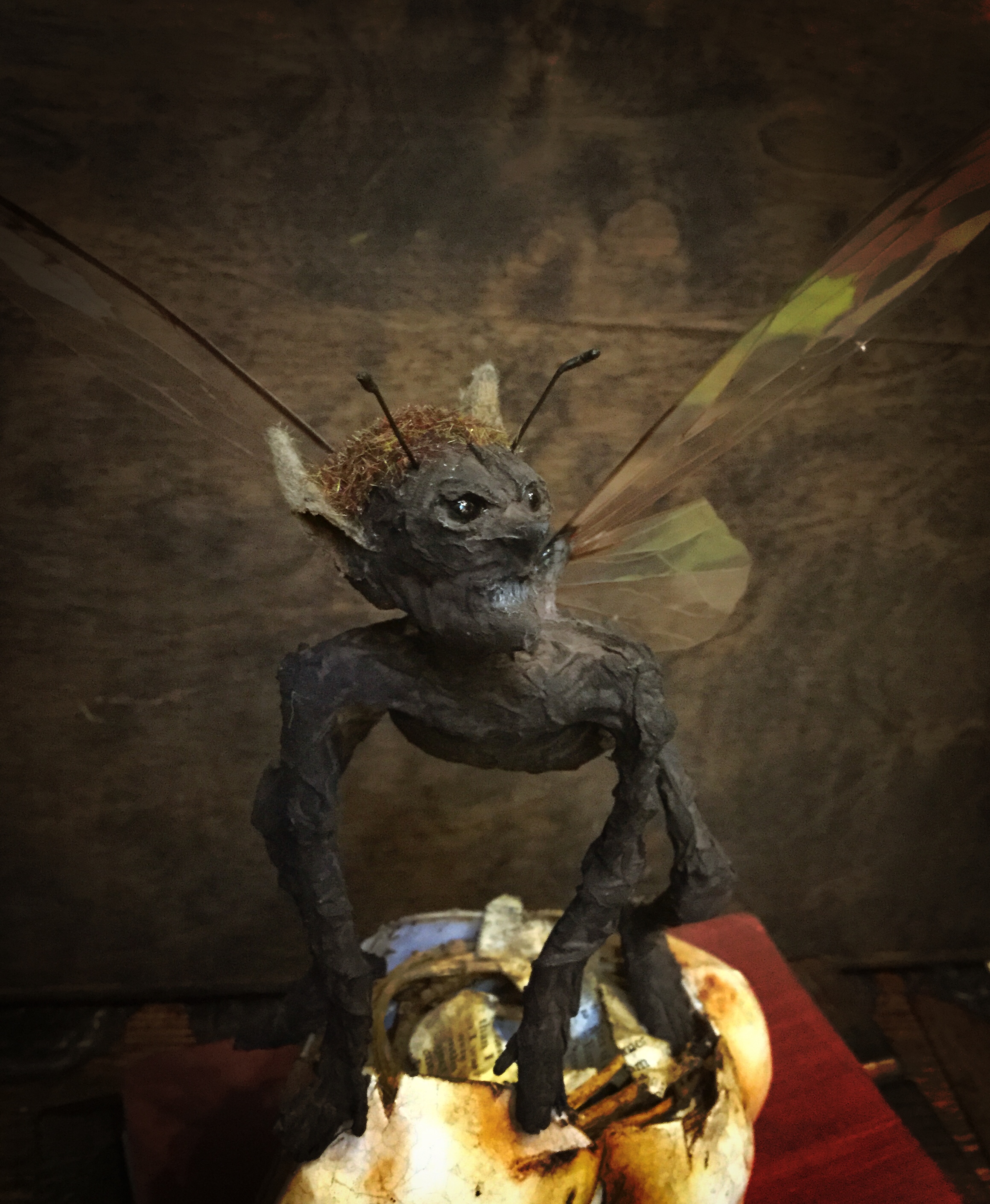
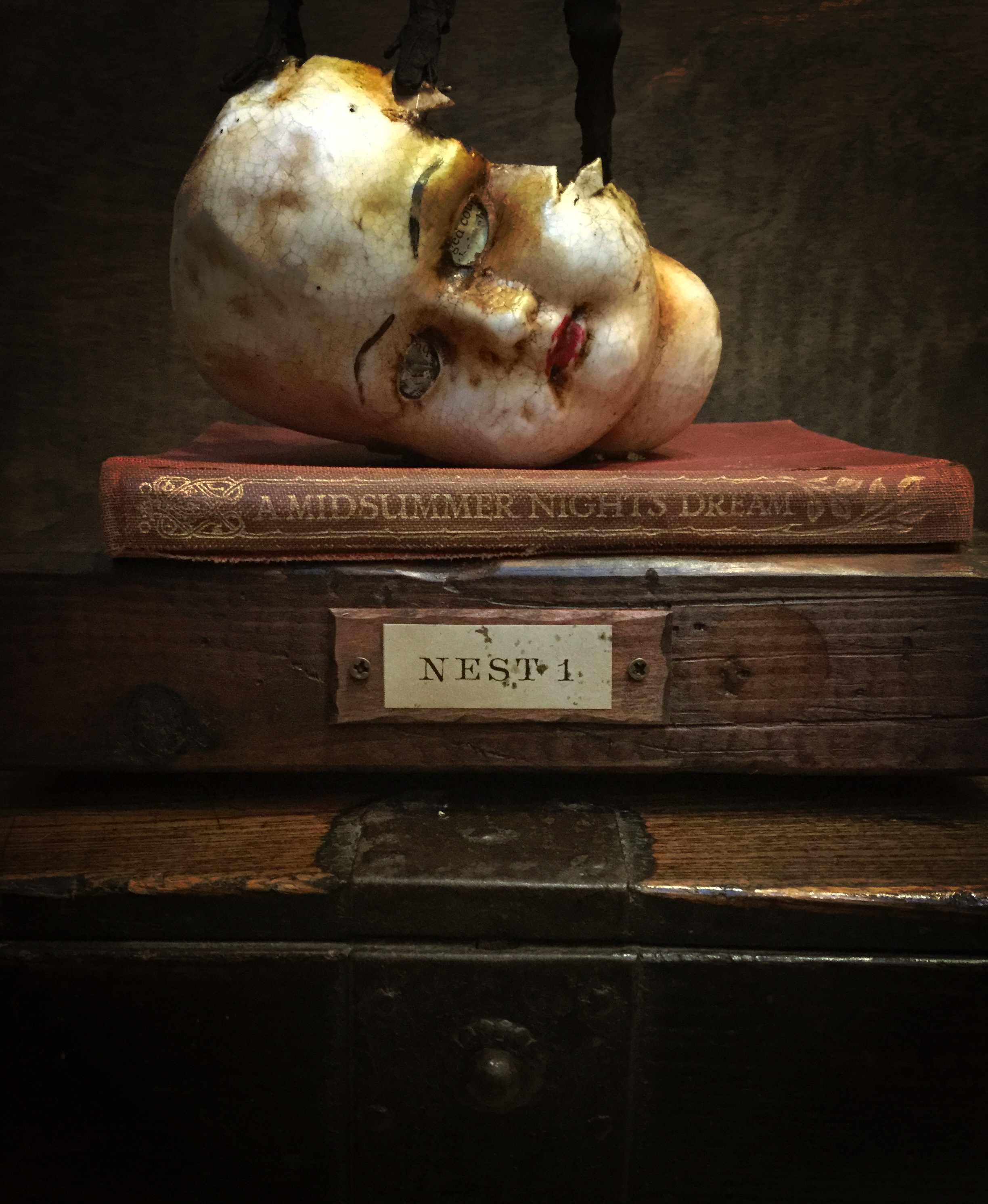
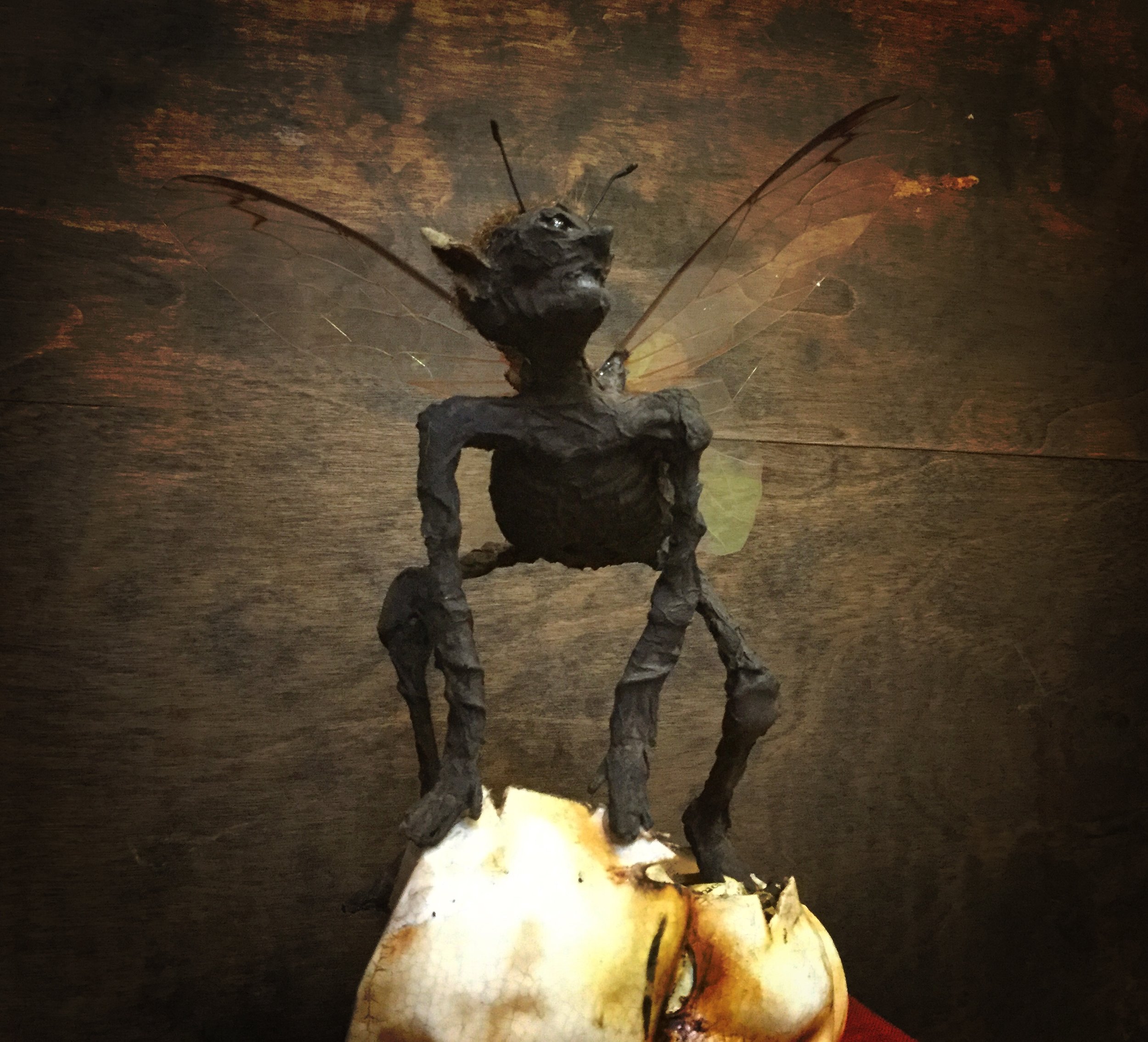

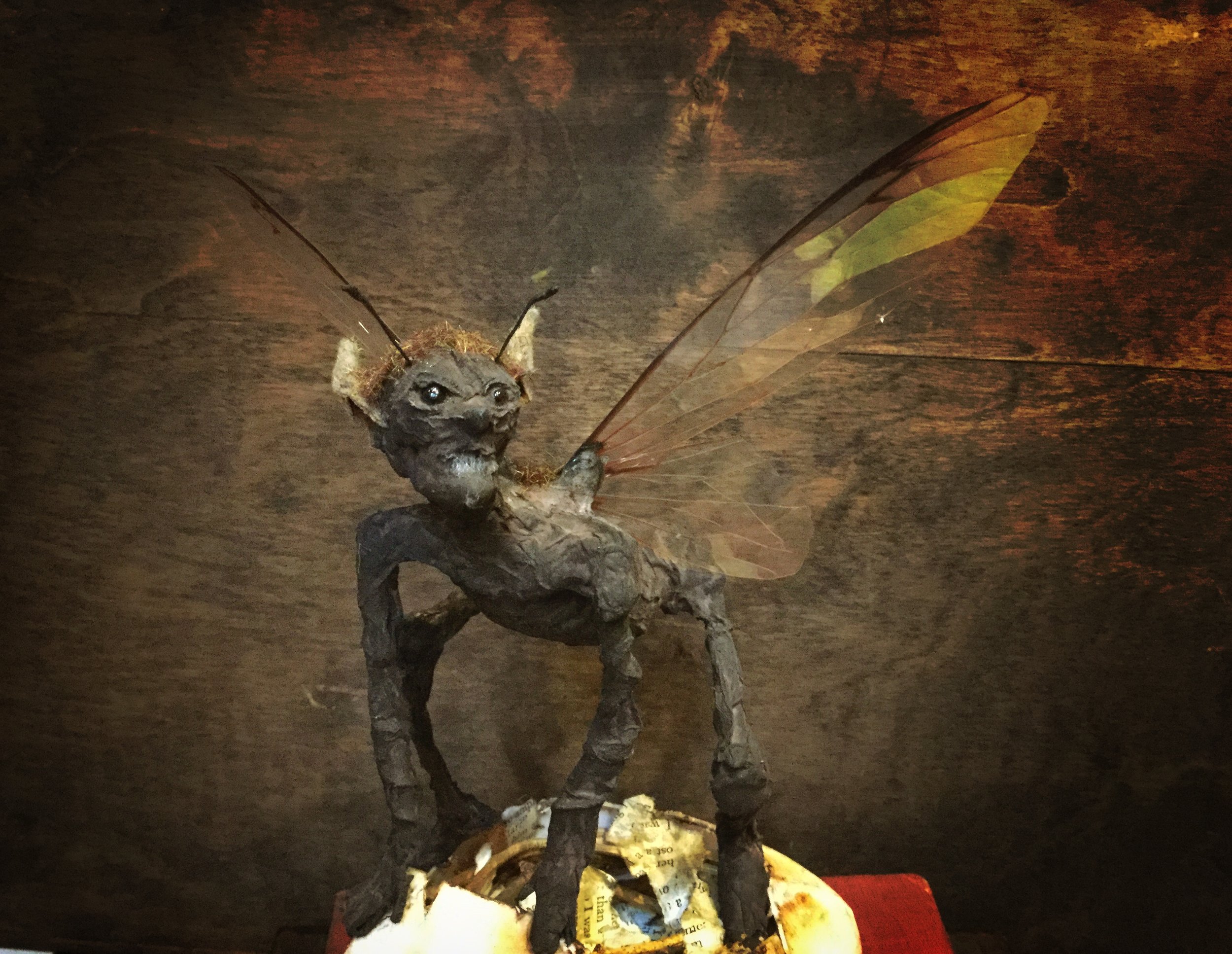
Paranormal News Insider Radio Discusses Pixie Bones
A week on and the story of the Pixie skeleton is still doing the rounds in the US. This week it was covered by The Paranormal Insider Radio Show which is hosted by Dr. Brian D. Parsons who has a wide background in paranormal investigation, UFOlogy, and cryptozoology, is an author of six books and is a public speaker on a variety of topics.
Dr Parsons contacted me prior to the show to ask if I had further information on the Pixie. I pointed him towards my last blog post and until the German facility releases more information we're kind of all left in the dark. Personally, I'm under the impression we will never hear from them again and the bones now reside boxed up in some huge warehouse alongside the Ark of the Covenant and a myriad of other artifacts that the government don't want us to know the truth about.
The Pixies is discussed from 18:00.
You can also listen to episode 7 of The Mystic Menagerie Podcast where Freddie Valentine and I talk about the Pixie bones for the very first time (starts 17:00)
Pixie Skeleton Mystery Reappears in the US
Almost 2 years after The Mystic Menagerie Podcast ran the Cornish Pixie Remains story, it has reemerged in the USA. Like all the great British TV comedies, the original story and images have been recycled for the American audience by a mysterious chap called James Cornan of Wilmington, North Carolina. Other than the location, the story of the Pixie skeleton discovery was copied verbatim and submitted to the 'Pictures in History' Facebook page where it was picked up by the US press. The newspapers didn't have to dig far before they realised it was initially featured on this blog back in 2016 and not only linked the page but also named me as the originator.
I'd personally like to thank James Cornan, The Charlotte Observer, The Asheboro Courier Tribune, The News & Observer, and the Pictures in History Facebook page for giving this story the exposure it deserves. Although the story was a hit in Japan and featured on prime time TV (see below), it failed to gain traction in the UK and Europe, but it appears that it has been a hit in the US. The Facebook article has been seen by 18K people, received 2K comments and been shared 25K times. Assuming a simple reach of 50 people per share, it’s been seen by 1,250,000 people. My blog page also received a staggering 17K views in one day and the Youtube video has be viewed 53K times.
The Pixie bones now reside in a secure facility in Germany where biological specimens that defy conventional science are stored. The mystery of the Pixie bones has never been solved and remains one of this century's greatest mysteries.
The attempt to prove the existence of fairies
Here's an interesting article from OZY which discusses various scientific attempts to prove the existence of fairies and similar creatures. Most of the theories are flawed from the outset and are derived from bizarre ideas such as a race of pygmies living under Stonehenge! Enjoy...
They used to be normal. Stolen away into the jungle by evil wizards who cut out their tongues, the Asiki children were transformed, their woolly hair morphing into long, sleek locks. Witchcraft destroyed their memories, and the poor, cursed children wandered the streets on dark nights in search of their long-lost homes. Or so the story went.
But Dr. Robert H. Nassau wanted to set the record straight. An elderly Christian missionary stationed in Libreville, French Congo, in 1901, Nassau, who was spiritual but not superstitious, patiently explained to townsfolk that they had nothing to fear from this mythical race of “little people.”
He had no time for such nonsense and always tried to refocus the conversation back toward his brand of Christian scientific rationalism … that is, until one particularly dark, moonless evening. With the sky covered in thick clouds, Nassau went for a walk and noticed a strange little figure following him. Upon closer inspection, he saw how the figure had strange, long black hair and struggled with a tongueless mouth to respond to his queries. A man of science, the Frenchman chased after the small being in hopes of capturing it for examination. But the only thing he caught, according to his mission log, was a single snippet of strangly, silky hair.
This account is an example of the late-19th and early-20th century’s fascination with euhemerism, the attempt to prove the existence of fairies (and other myths) through science and anthropological study. Tales like Nassau’s thrilled Victorian and Edwardian audiences, whose interest in mythical people was ignited by a growing sense of nationalism and the rediscovery of Shakespeare, particularly the Bard’s enchanting fairy-driven romance, A Midsummer’s Night Dream. Nassau’s telling reflects an effort to try and reconcile turn-of-the-century fairyphilia with the climate of scientific rationalism that characterized the Industrial Revolution.
Some 19th-century euhemerists like Alfred C. Haddon, George Laurence Gomme and John Stuart Stuart-Glennie argued that fairy tales were creative retellings of racial clashes in Bronze Age Britain. Haddon believed, for example, that fairy tales could be read “as stories told by men of the Iron Age of events which happened to men of the Bronze Age in their conflicts with men of the Neolithic age.”
The most sensational of the 19th-century euhemerist theories was presented by Scottish writer David MacRitchie in The Testimony of Tradition (1890). In this study, MacRitchie argued that fairies were actually a pygmy race of ancient Britons who once lived in the underground tombs and passageways found around archaeological sites like Stonehenge. Georg Schweinfurth’s discovery of African pygmies in the 1870s supported MacRitchie’s hypothesis, and when in the course of colonial expansion, R.G. Haliburton found a race of dwarfs living in the Atlas Mountains of southern Morocco, his theories seemed irrefutable.
Today, we know MacRitchie’s theories were wrong: “Advances in … archaeology, linguistics, anthropology and so on have since demonstrated that euhemerism might have been intellectually attractive but was not historically true,” says Adam Grydehøj, lead editor of Island Studies Journal. We now know that “a race of pygmies did not inhabit Europe prior to the arrival of a hypothesized race of Aryans.”
This approach to euhemerism combined Charles Darwin’s sensational theory of evolution with folklore, creating a scientific theory of fairies as a forgotten humanoid race. But other euhemerists, like Englishman Robert Southey, linked the fairy myth to St. Patrick’s mythical expulsion of Ireland’s snakes. The story of St. Patrick is said to be an allegorical retelling of the conversion of the Irish from paganism to Christianity in the fifth century, with the snakes representing Druidic priests who were known to have serpents tattooed on their forearms. So this branch of euhemerism claimed that the Druids, fearing persecution from their Christian
Even well into the 20th century, fairy theories evolved to reflect scientific and technological advancements. The most famous example? None other than Sir Arthur Conan Doyle’s attempts to explain the famous Cottingley fairy photographs through electromagnetism. Taken by cousins Frances Griffiths and Elsie Wright of Yorkshire — they later admitted the photos were a hoax — these pictures depicted fairies with incandescent wings and stooped mischievous gnomes dancing and frolicking around the teenagers. “The Cottingley Fairies” consumed Conan Doyle’s imagination, prompting him to write a book in 1922 titled The Coming of the Fairies, based on his research and experiences with the girls.
Doyle theorized that fairies existed on a different vibrational spectrum, like X-rays or ultraviolet, and could be seen only by those who could “tune in to” their world. He also guessed that the reason Elsie and Frances’ fairies seemed two-dimensional was because fairies were made of pure light and cast no shadow. In reality, the fairies that baffled and enchanted a nation were nothing more than cut-out fairy-tale illustrations propped up by hat pins.
In a world rocked by dizzying techno-scientific discoveries, it seems that euhemerism and other fairy theories were a way for people in the 19th and early-20th centuries to reconnect with simpler times — ones filled with mystery and enchantment.
Mummified Fairy Inspires New Horror Short 'Latched'
The 2007 Mummified Fairy makes her first movie appearance!
Playing as part of the 2017 Toronto Film Festival‘s shorts programme is Justin Harding and Rob Brunner’s Latched.
From the Press Release:
Newly-single mom Alana (Alana Elmer) and her 14-month-old son Bowen (Bowen Harding) are alone in the off-season on an island cottage, with only a strange old neighbour (Peter Higginson) for company.
A choreographer looking to get back into the dance world, Alana uses her time of solitude to practice her moves and prepare for a new adventure involving an experimental dance company. Then on a walk in the woods with Bowen, they discover the decomposing remains of what is dubiously identified as a bat. It is not a bat.
That’s the bare and chilling premise of Latched, directors Justin Harding and Rob Brunner’s latest horror short, which is debuting at the Toronto International Film Festival, opening the Shorts Program.
No stranger to the concept of terror-and-children, Harding and Brunner recently turned heads with Kookie, a short, terrifying film about a greedy little girl, a haunted cookie jar and a killer clown, which earned an Official Selection at SXSW and won of over 30 awards.
What distinguishes Latched, however, is that it is a meta-project involving Harding’s real-life wife and child, a maternal dynamic the filmmaker knew would translate to the screen powerfully.
Elmer (who also starred in Kookie) actually is an acclaimed dancer with the Toronto Dance Theatre and emerging from maternity leave with her son Bowen. The rotting “fairy creature” that terrorizes her is fellow professional dancer Jarrett Siddall.
And, in a full-circle move that’s further representative of the film’s intimate creative approach, Harding convinced a major mentor of his youth – his film class and visual storytelling teacher Dale Andrews – to join as executive producer, bringing with him the passion that first inspired him 16 years earlier.
“It’s a new type of genre film,” says Harding, “inspired by a desire to produce something uniquely beautiful and shocking involving immediate family and cherished friends.”
“Latched was designed to dance between the frightening and the artistic,” Brunner adds. “This story could only be told with the honest dynamic of a mother and son whose real relationship lures the viewer deeper into an unexpected nightmare.”
Harding and Brunner are reality-TV veterans with an urge to go surreal. Brunner has directed The Amazing Race Canada, Wild Things with Dominic Monaghan and Top Chef Canada, while Harding has produced The Amazing Race Canada, Master Chef Canada and more.
“Everything we’ve done has been with a mind to getting back to our roots,” Brunner says. “We approach everything we do, including the big reality shows, with a film-making approach. It’s truly where our heart is. Justin and I have worked together for many years and share a creative eye.”
Harding and Brunner have gone on to create The Bokeh Collective, with a goal “to push the boundaries of epic storytelling.” The company is working show-running four different American documentary series. Having shepherded their work through the most prestigious showcases and festivals in film, they are ready to expand their creative journey to include feature-length production.
Indeed, Latched is a short film with a feature-length sensibility. Its score was created in collaboration with composer Vivien Villani, who conducted original music with a 19-piece orchestra.
“To call it a passion project would be an understatement,” Harding says. “We are beyond excited to share our crazy little film with everyone at TIFF.”
Hellboy reboot without Guillermo del Toro announced
It seems that Hollywood is hellbent on rebooting nearly every classic they can get their greedy hands on. After a shameful selection of half arsed reboots such as Poltergeist, Ghostbusters and a hundred versions of Spiderman it would appear that no movie franchise is safe from the Hollywood cash grab. Hellboy is up there with one of my all time favourite movies closely followed by Hellboy II : The Golden Army, yet it has been announced that the cult classic is getting a reboot WITHOUT Guillermo Del Toro as director. Hellboy II left us on a cliffhanger with Liz Sherman pregnant with Hellboy's child but unfortunately, the tale ends there for fans of the original adaptation of the Mike Mignola comic.
It's a huge shame that Del Toro didn't get the funding for a third installment and I sincerely doubt that anyone will top Ron Pearlman as Hellboy. I might be wrong but given the standard of recent Hollywood releases such as The Dark Tower, Valerian and The Mummy I don't have high hopes for this reboot. If it's not broken, why fix it?
The following article is taken from The Independent -
Despite being met with a relatively tepid box-office reception, Guillermo del Toro’s Hellboy, and 2008 sequel Hellboy II: The Golden Army, have gained a somewhat cult following.
Earlier this year, Del Toro confirmed a third instalment would not be happening. Now, we seemingly know why; the series is being rebooted, with a new director, actor, and an adult-orientated R-rating.
Hellboy’s creator Mike Mignola announced the news on Facebook, saying Neil Marshall — best known for directing horror film The Decent, along with various episodes for Game of Thrones, Westworld, and Hannibal — will direct the project.
Stranger Things actor David Harbour will play the titular character, who was previously played by Ron Perlman.
The reboot and re-launch of the series also has a title — Hellboy: Rise of the Blood Queen — and has been confirmed to have an R-rating, something that will likely bring the films closer to the darker tones of the comics rather than family-focussed Del Toro series.
The Hollywood Reporter confirmed the news, adding that comic book author Andrew Cosby, Sons of Anarchy novelist Christopher Golden and Mignola will pen the script.
According to the publication, Del Toro met with Dark Horse Entertainment, along with producers Larry Gordon and Lloyd Levin, to discuss future ideas for the series. The report details how the Mexican director wanted a larger budget, something they were not willing to offer.
Del Toro previously said of Mignola pressing on without him: "Hellboy may move into a different direction. I tried & wanted this - but, not up to me. I, for one, wish everyone involved the best of luck! "
The Box of Astaroth - Dark Rituals Edition
It's been a while since I last completed a Box of Astaroth and the first five months of the year seem to have passed by without me seemingly doing much as all. Thankfully the client who commissioned this has patiently waited while I completed other projects, organised Doomsday and taken care of two new additions to the family.
The client wanted an innocent looking box that would inconspicuously grace any mantlepiece yet it would harbour some very dark contents. The key phrases he used were altar, strange equipment, forbidden arts and devil worship.
The strange occult fetish is a fetus skull adorned with bells and bones. Spells and curses have been hammered into the head with coffin nails; reminiscent of rituals past. The dark history that surrounds this box and the evil it has witnessed are up to the client to fabricate but I think I've given him enough mileage for a convincingly disturbing tale.
As always, I have used original antiques where possible and it retails all the functionality of previous boxes.
Phantoms of Snowdon
What with trying to complete a multitude of projects and attempting to write a book, the poor old blog has been feeling rather neglected of late. It's not that I don't have anything to post, in fact it's the opposite. I have a whole host of interesting snippets, thoughts, urban exploration reports and creative splurges I need to vent so I thought I'd start with my drone footage from 2016.
The following footage was shot in one day with my son on our annual climb of Snowdon in Wales via the Rhyd Du path and back down via the Ranger Path. The weather was perfect for filming with almost zero wind, even at the summit. Ithis allowed me to fully test the range of the Phantom 4 and I was able to fly for over 2km without any drop in video link. The initial footage flying across the lake and up the waterfall was a continuous flight in one direction, a round trip of 4km! At the higher altitudes I did lose the drone in cloud a few times but the Return to Home function worked like a dream and my bird came back to me at the touch of a button. What struck me was the feeling of vertigo even with my feet firmly planted on the ground as I watched the monitor screen. Watching the point of view camera of the drone soaring off a cliff thousands of feet up at 40mph left me with a dizzy head and a surge of adrenaline I wouldn't normally have expected.


